This is the ninth post in my family culinary history series. To start from the beginning, please see my Connecting with my Ancestors through their Recipes post.
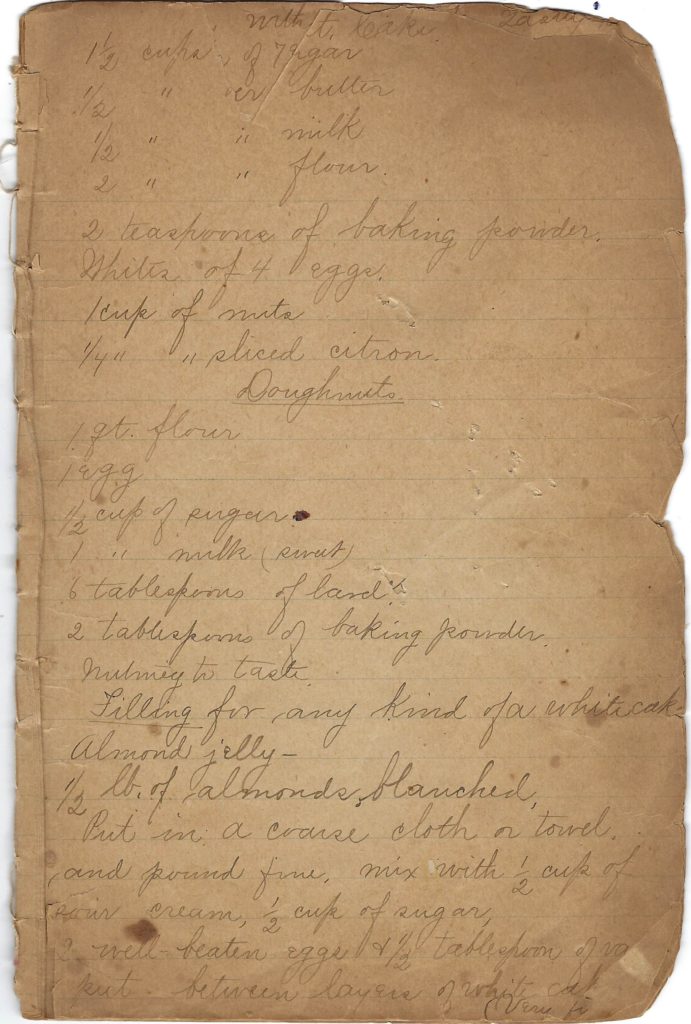
Doughnuts
1 qt. flour
1 egg
½ cup of sugar
1 cup of milk (sweet)
6 tablespoons of lard
2 tablespoons of baking powder
Nutmeg to taste
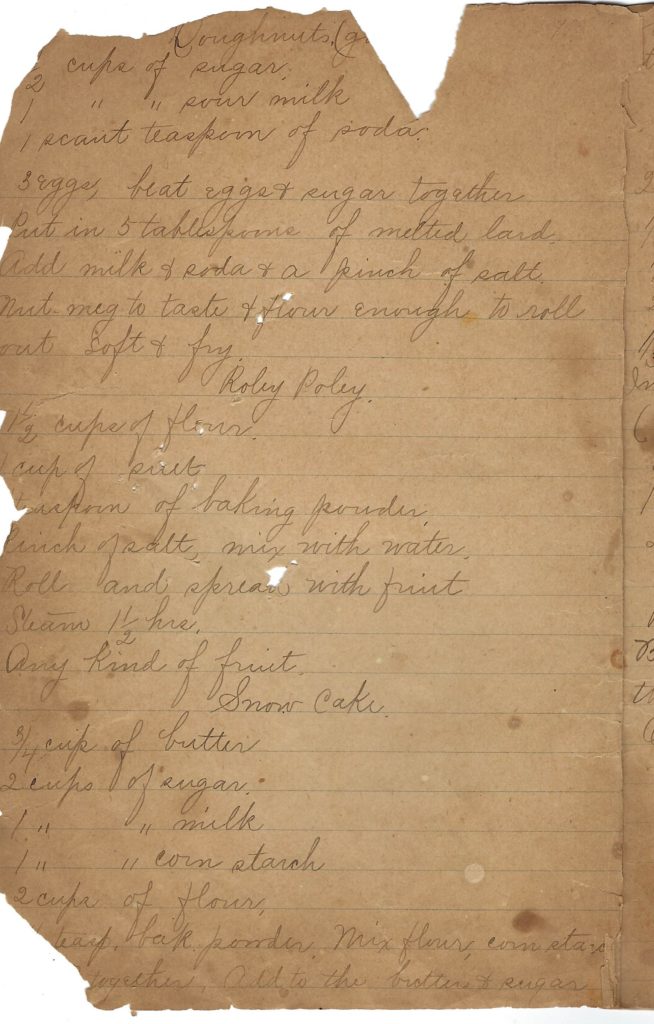
Doughnuts (good)
½ cups of sugar
1 cup of sour milk
1 scant teaspoon of soda
3 eggs, beat eggs and sugar together
Put in 5 tablespoons of melted lard
Add milk and soda and a pinch of salt
Nutmeg to taste and flour enough to roll out soft and fry
This whole adventure really kicked off with my coworker asking me to make her some doughnuts. I have wanted to make doughnuts for a while and had a huge collection of fancy doughnut recipes archived away but could not justify just making them for myself, so I was understandably excited by being handed an excuse to whip some up finally.
Then I remembered that Irene’s manuscript even had a couple of doughnut recipes in it. So, I could kill two birds with one stone — learn how to make doughnuts while also crossing some recipes of hers off my to make list!
However, as always, there were several steps between the thought and the execution that made things easier said than done.
Two Versions
As mentioned above, Irene had two versions of doughnuts (not including a number of “fried cakes” recipes which I decided to keep separate).
She explicitly labeled one recipe as “good,” but didn’t say why so I was curious what the difference between the two doughnuts were and if I thought that one really was better than the other.
Therefore, a head-to-head battle was in order. Would I agree with Irene?
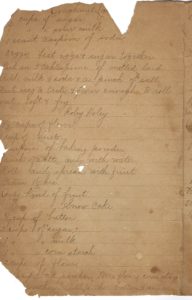
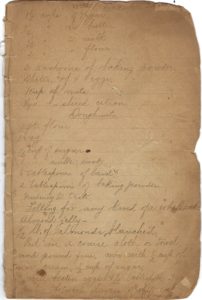
Directions
As with almost all of Irene’s recipes, the directions are spotty at best. She clearly assumed whoever read her recipes would be well versed in doughnut making, and might not have even considered someone other than herself would be reading her recipes.
All I can say is thank god for the internet and Google. After some quick searching, I was able to find a couple of great doughnut recipes from one of my favorite companies, King Arthur Flour, to fill in the gaps in Irene’s recipes.
Without those recipes, it would have taken me many shot in the dark experiments and guesses and lots of wasted ingredients trying to reinvent the doughnut wheel (and hole).
Baking or Frying
While not an extreme health nut, I have been trying to be a bit more health conscious these past few years, so deep fried foods have not been something I have tried to indulge in.
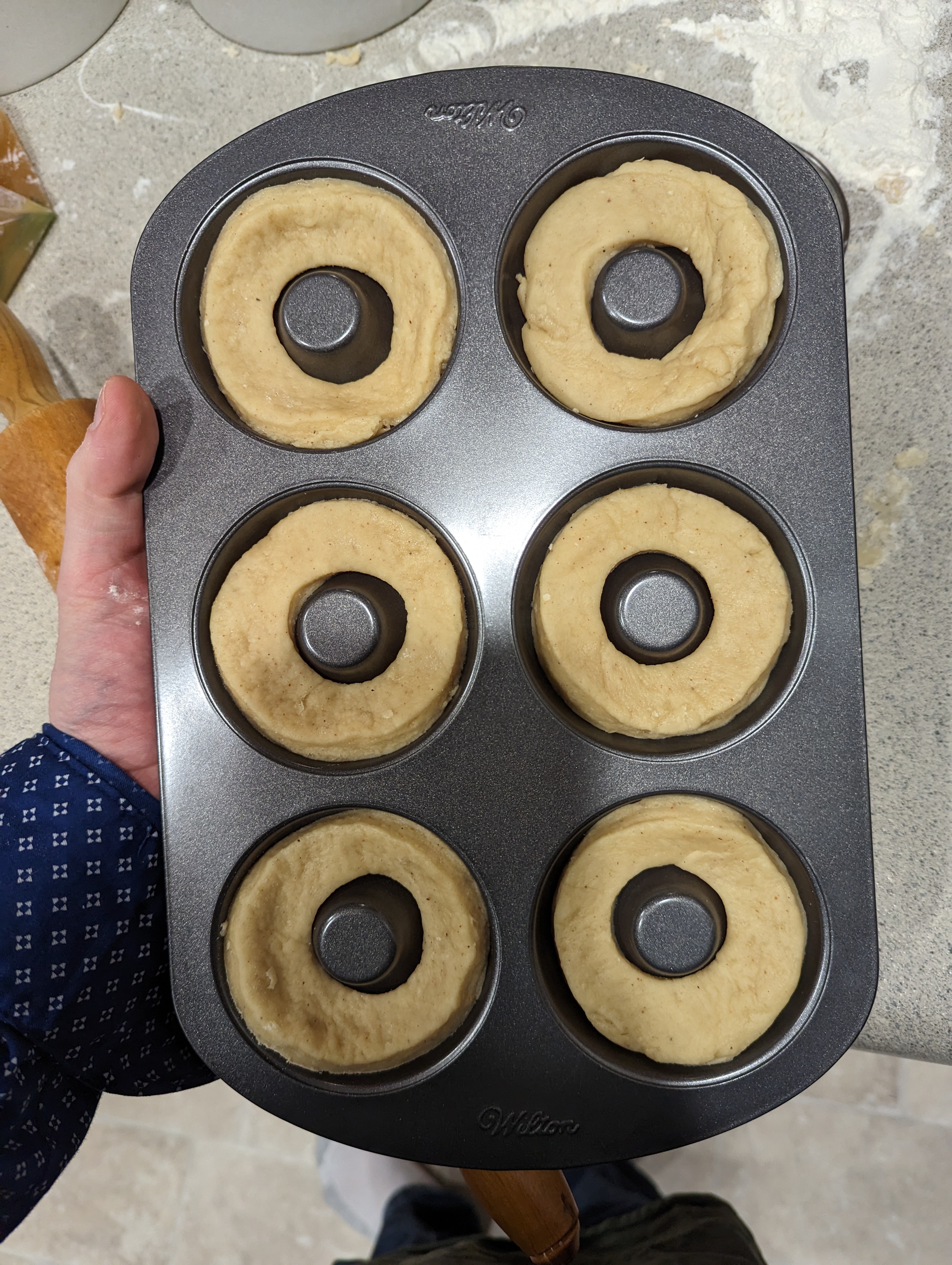
This made me a bit anxious when it came time to make these doughnuts because I wanted to try some but didn’t want to completely ruin my diet for the day. With lard inside the doughnuts as well as being deep fried, they were threatening to be quite calorie dense.
I’m definitely learning that Irene was not concerned so much with her waistline! I’m surprised her asparagus salad recipe didn’t include lard!
It seems obvious that baking the doughnuts would most likely be a healthier option than deep frying them, and I even had a couple of doughnut pans!
However, a big part of this whole project was to get to know Irene better through reproducing her gestures in the kitchen to sort of embody her through her actions, and she would have fried them.
But since I had the pans and had never even used them once, I had to at least bake a batch of doughnuts in them just for comparison.
Old School or New
A long time ago, I inherited a small deep fryer from a friend who could not move cross-country with it, but I never had a chance to use it. And just like my doughnut pans, at first I thought this might be a good opportunity to break the fryer in.
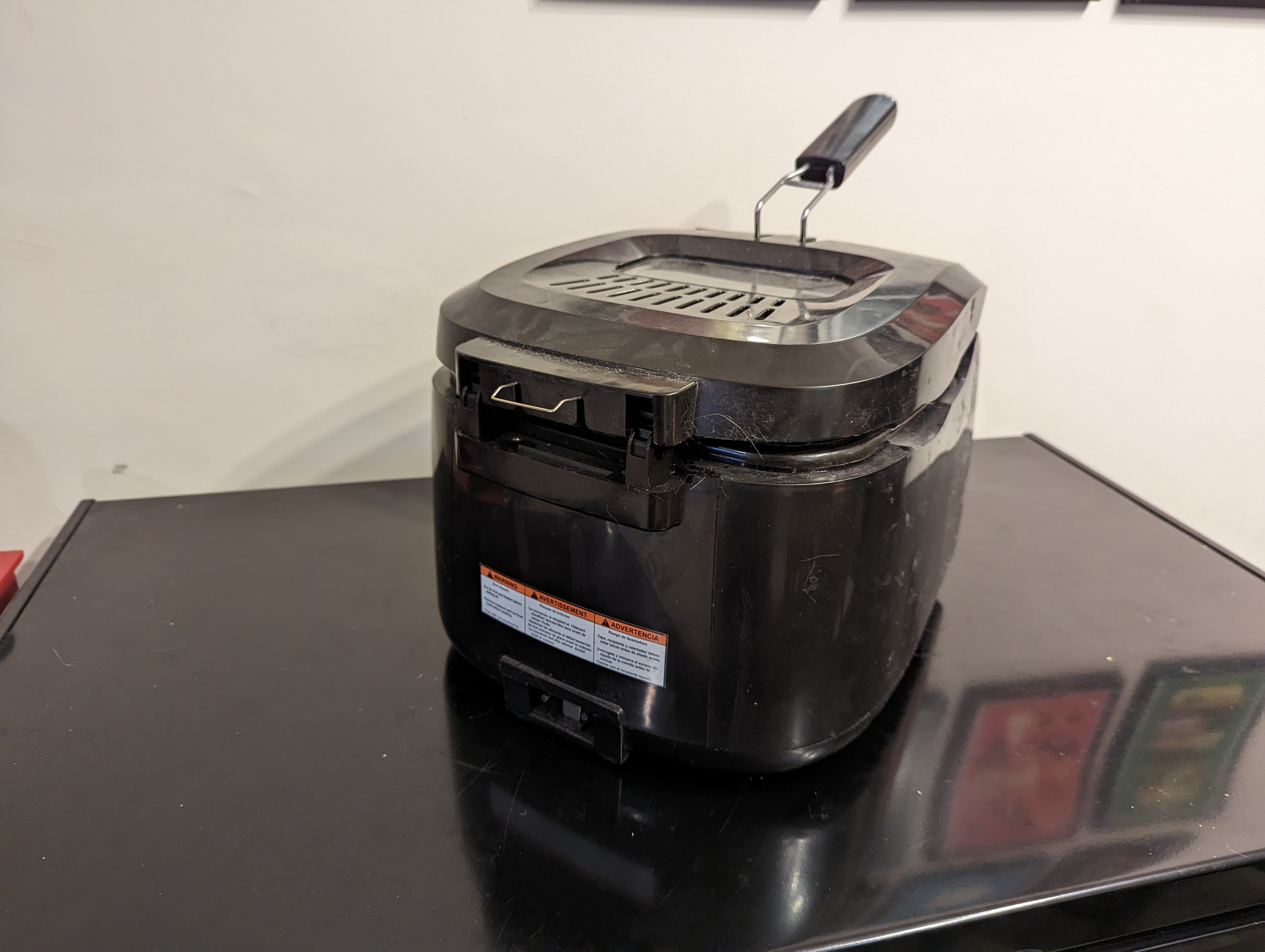
But I could just see Irene’s reaction if she was still alive and heard I was thinking about using some new fangled machine instead of just a simple big pot on the stove. So, I decided to save the deep fryer for another occasion.
Lard, Shortening, or Oil
The King Arthur Flour recipes gave three options for deep frying: lard, shortening, or vegetable oil. And they were pretty clear, I’m sure to Irene’s joy, that lard would impart the most flavor, even if it might not be the healthiest.
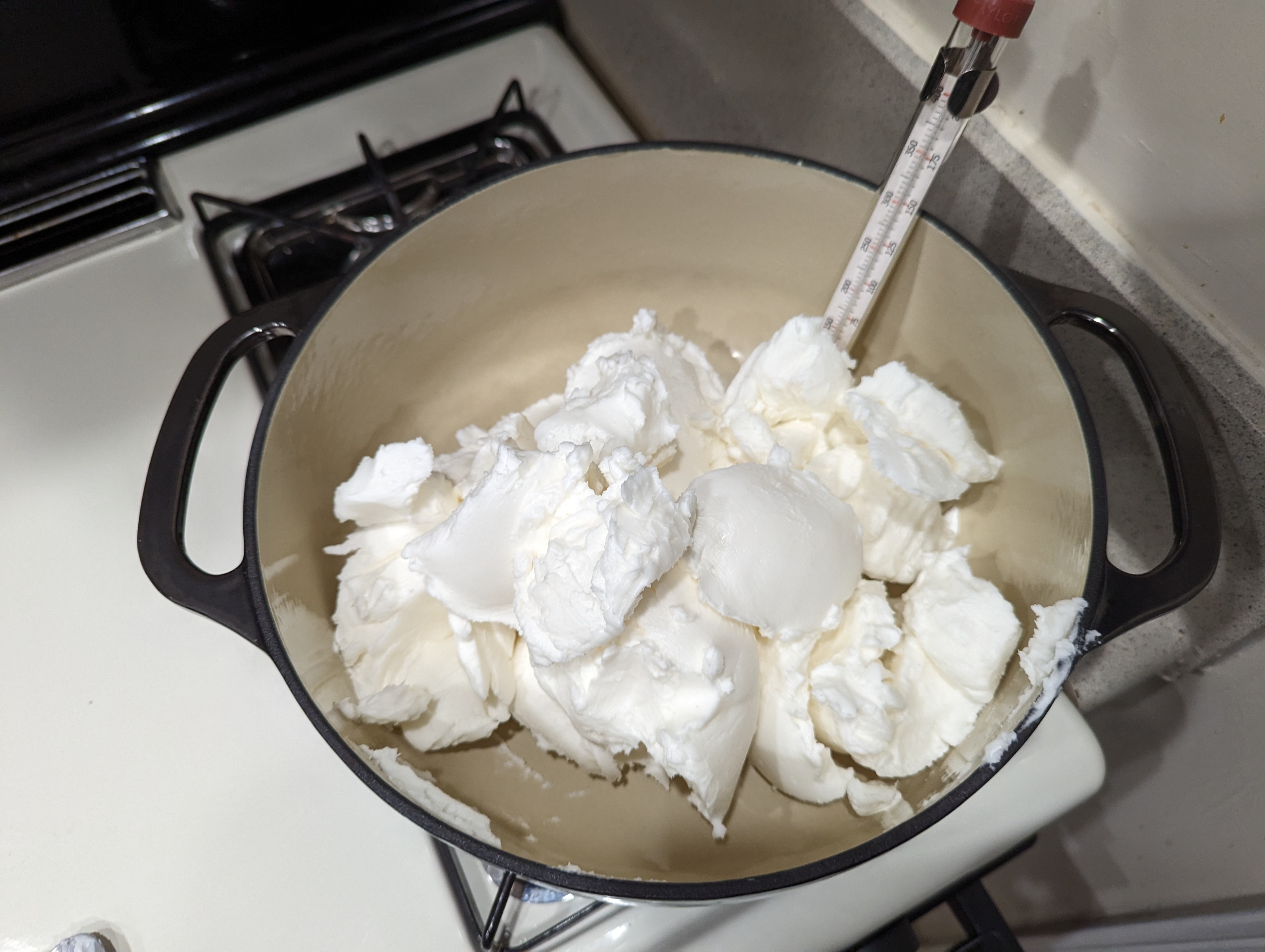
Since Irene seems to love lard and uses it everywhere (it’s even an ingredient inside the doughnuts), my plan was to deep fry in lard. However, despite finding a giant pyramid de la lard in a local grocery store when making Irene’s lemon pie, it appeared to suddenly disappear.
I tried several grocery stores and even called a butcher, but no luck! I don’t know if it was because it was an off-cycle of pig slaughtering, if lard is only really around during the holidays, if I was just looking in the wrong spot, or what, but I just couldn’t find any.
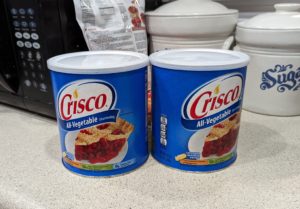
So, in the end, I just ended up going with shortening. Of which I actually ended up buying too much since I did not realize I could reuse the same batch of shortening for both recipes. So, now I have a giant container of Crisco taking up room in my cupboard! I guess it’ll come in handy when I make Irene’s fried cakes!
First Timer Crash Course
This was the first time I have ever deep fried anything, and I have to say that I was pretty nervous.
I know that deep frying can be very dangerous and can result in very bad burns or fires. It seems like every holiday season there’s some warning about people burning down their house while deep frying a turkey or something. Whether it actually happens or not, I don’t know, but the fear is real.
However, in the end, it turned out to be much easier than I was expecting, and I really only burned myself very slightly while doing something stupid like dropping a bunch of doughnut holes into the greese too quickly and from too high of a height because I was hurrying.
Moral of the story is just take your time and treat hot oil with respect and you should be fine.
Pictures, Video, and Tasting!
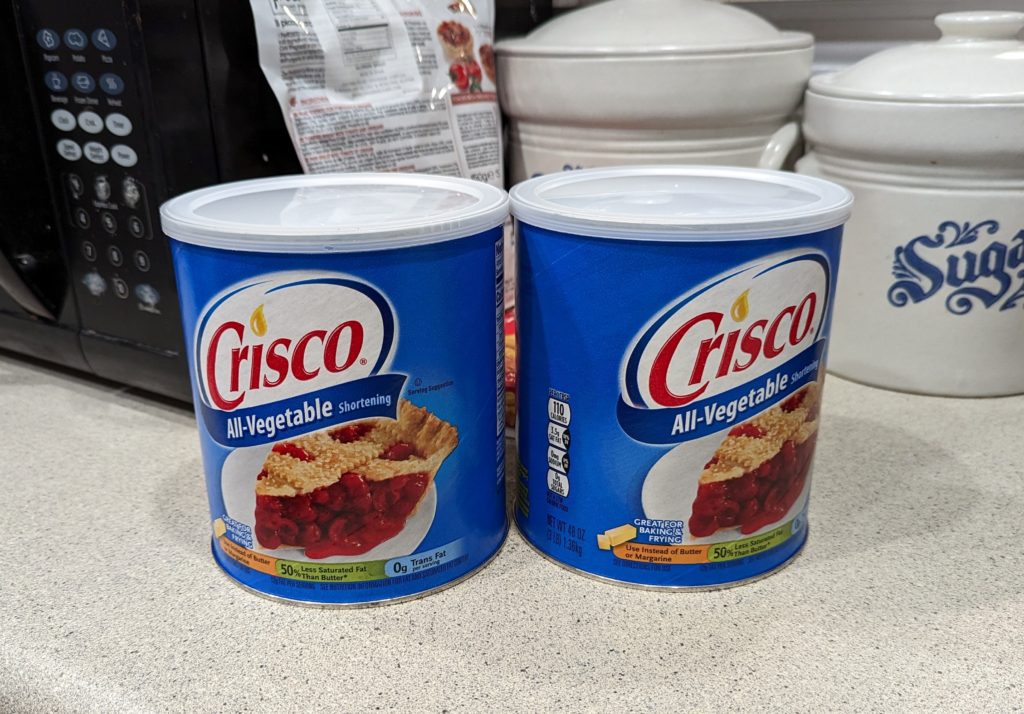

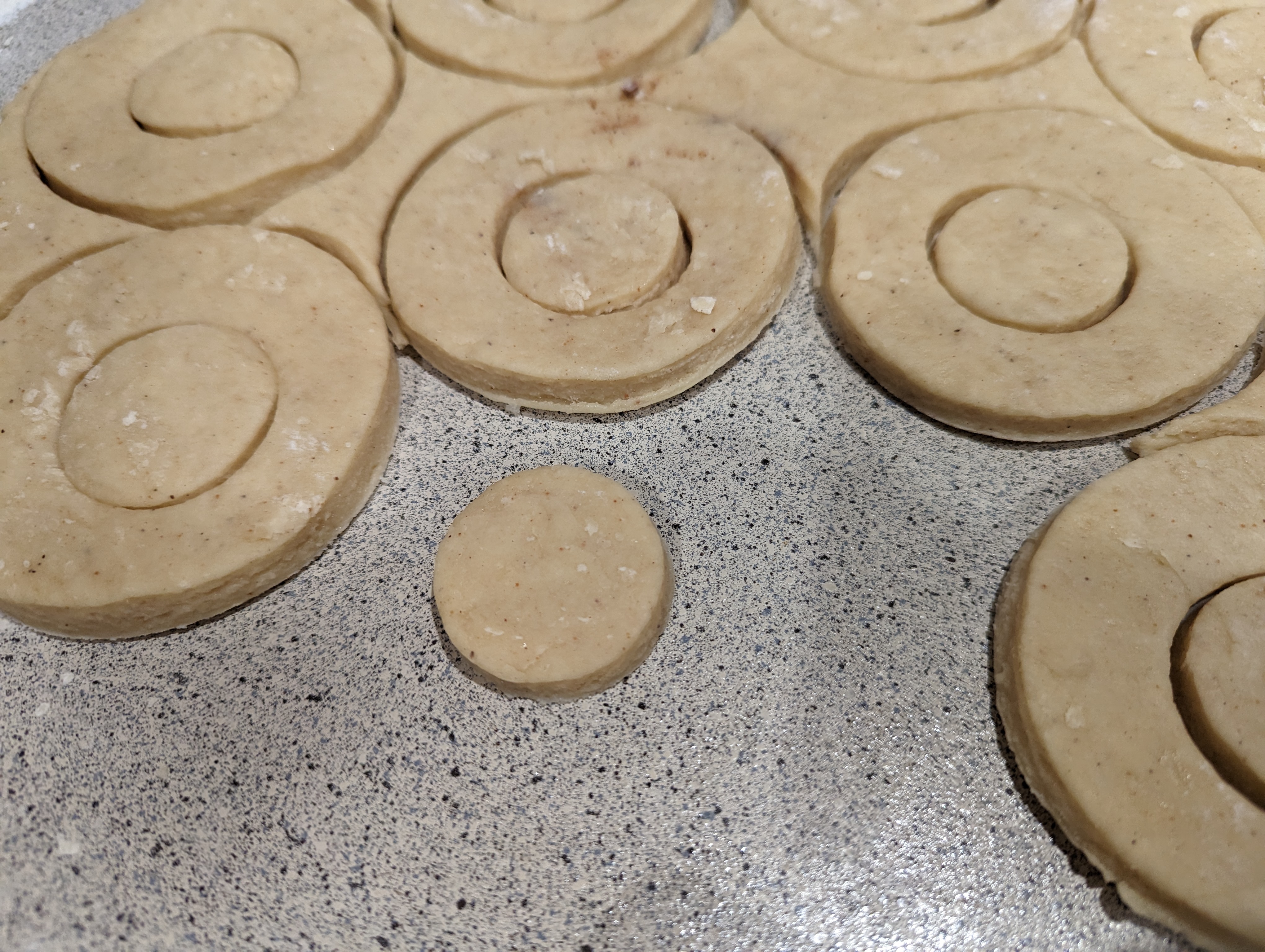
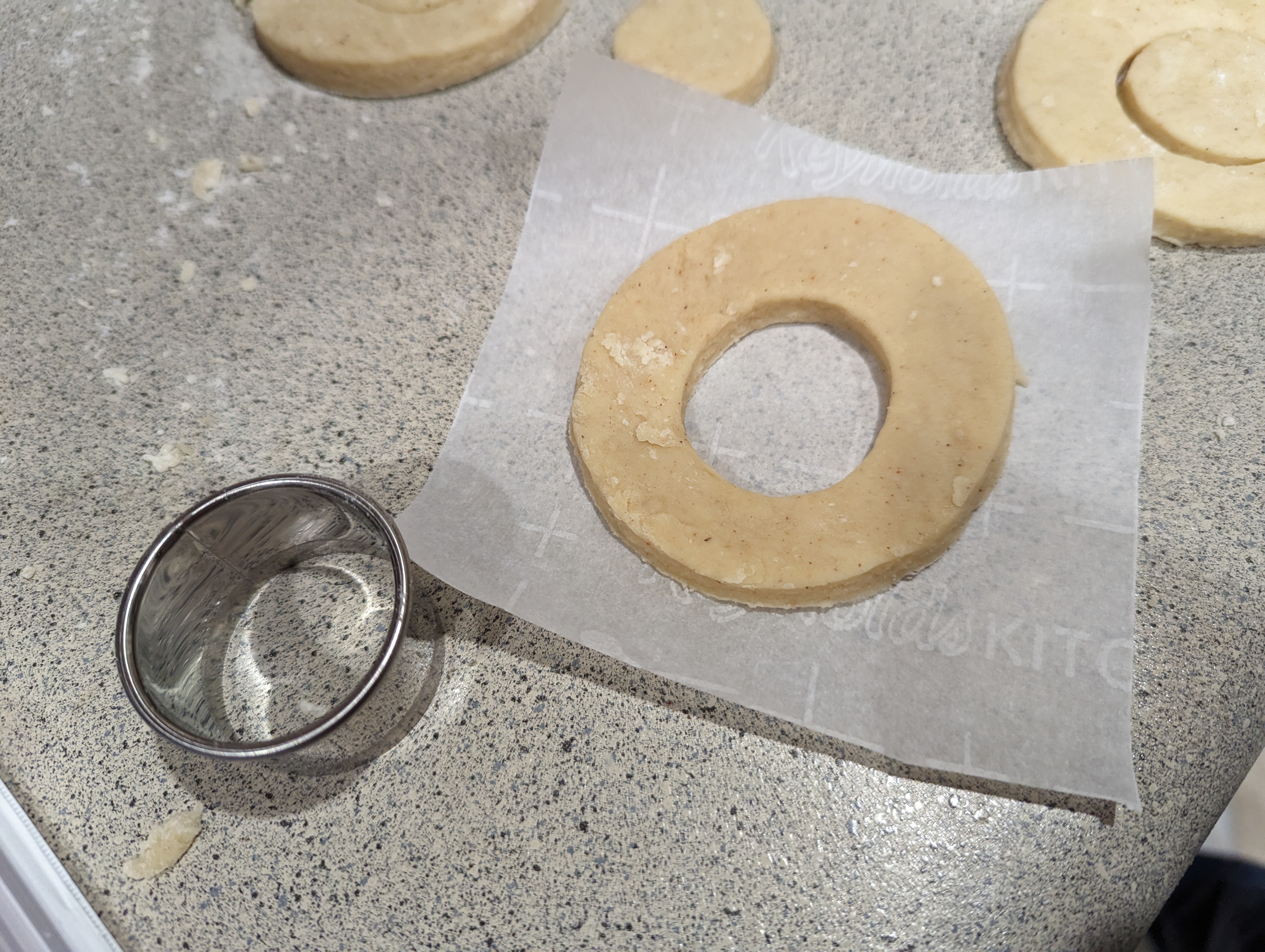
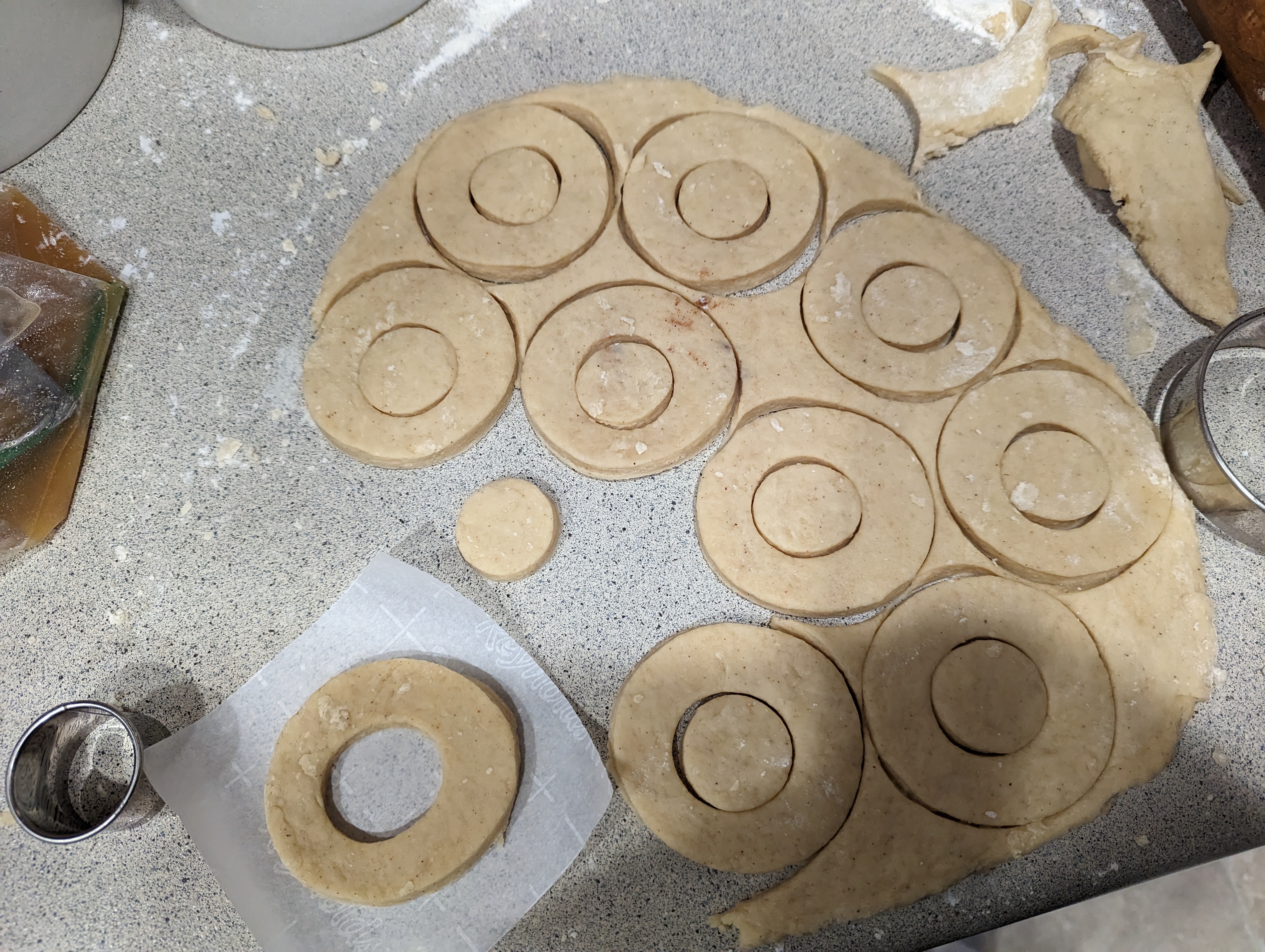
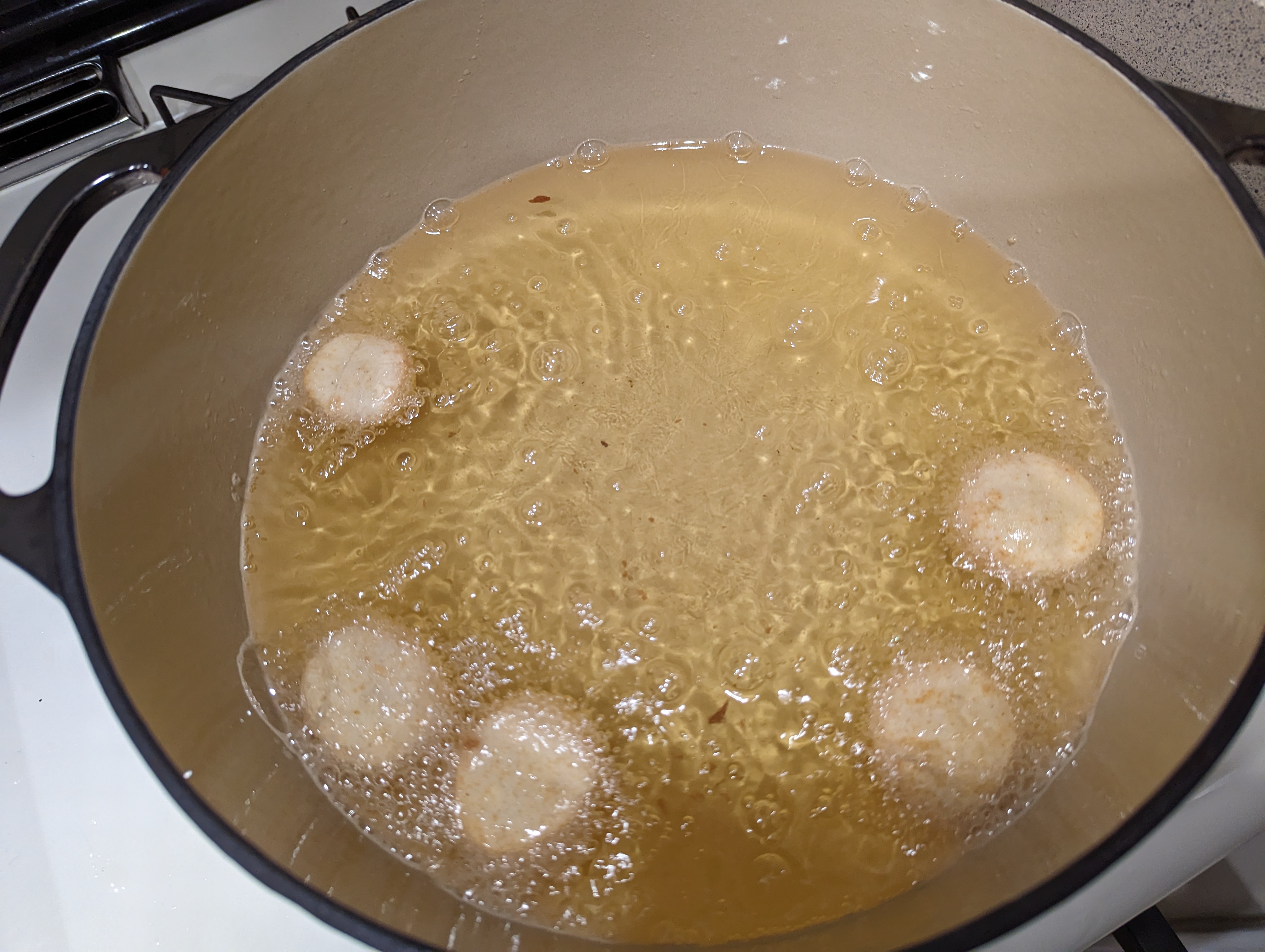
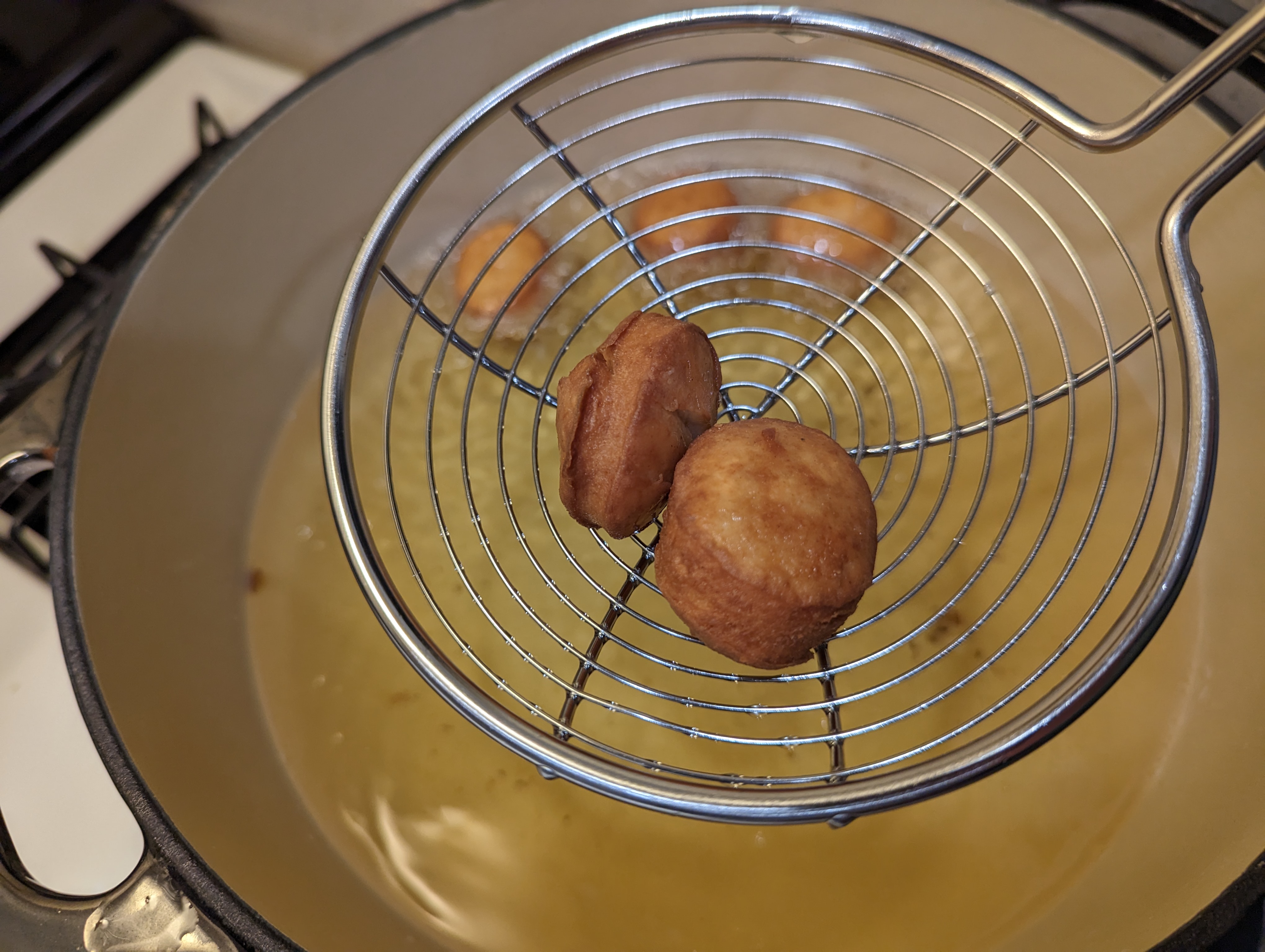
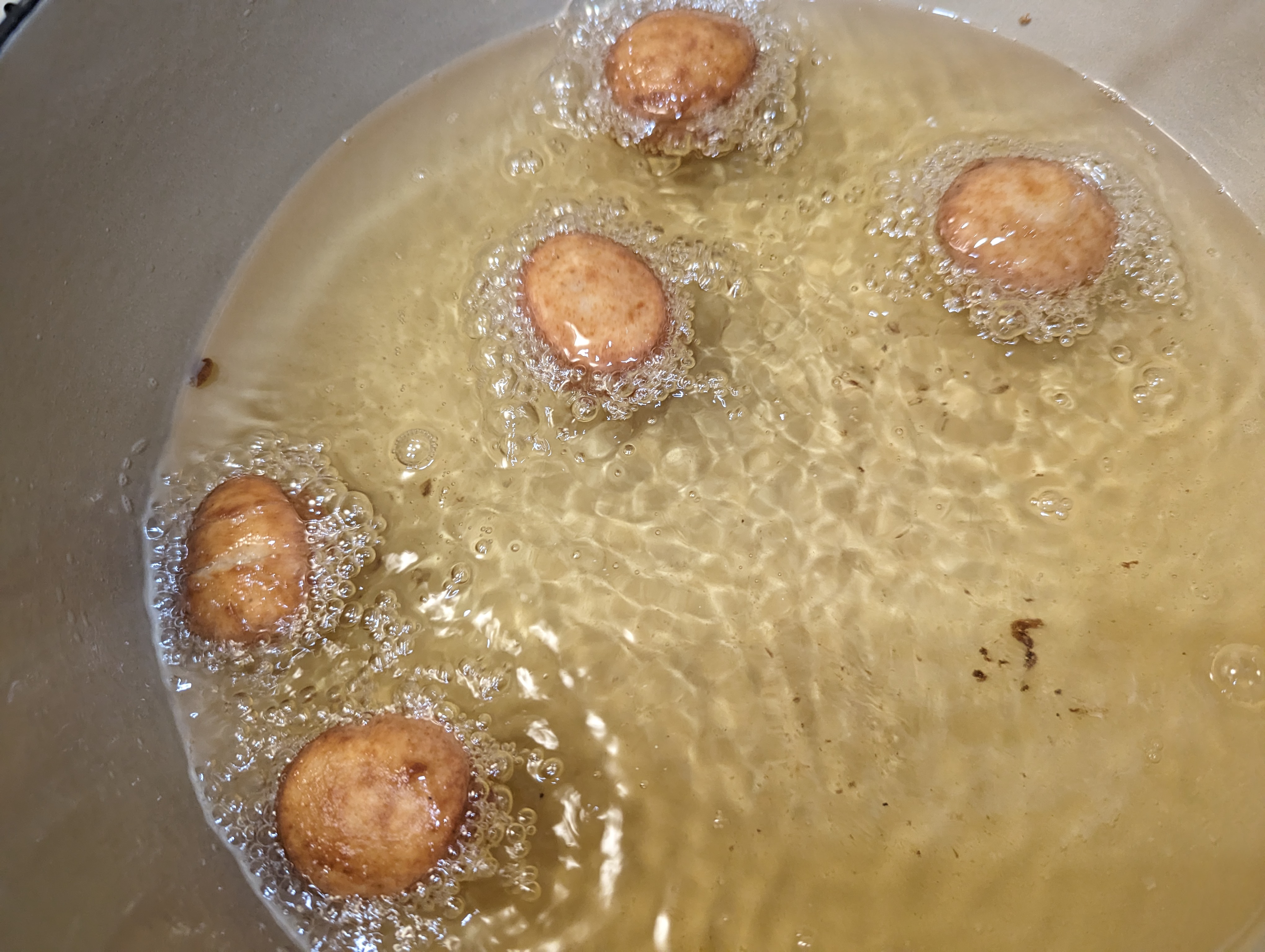
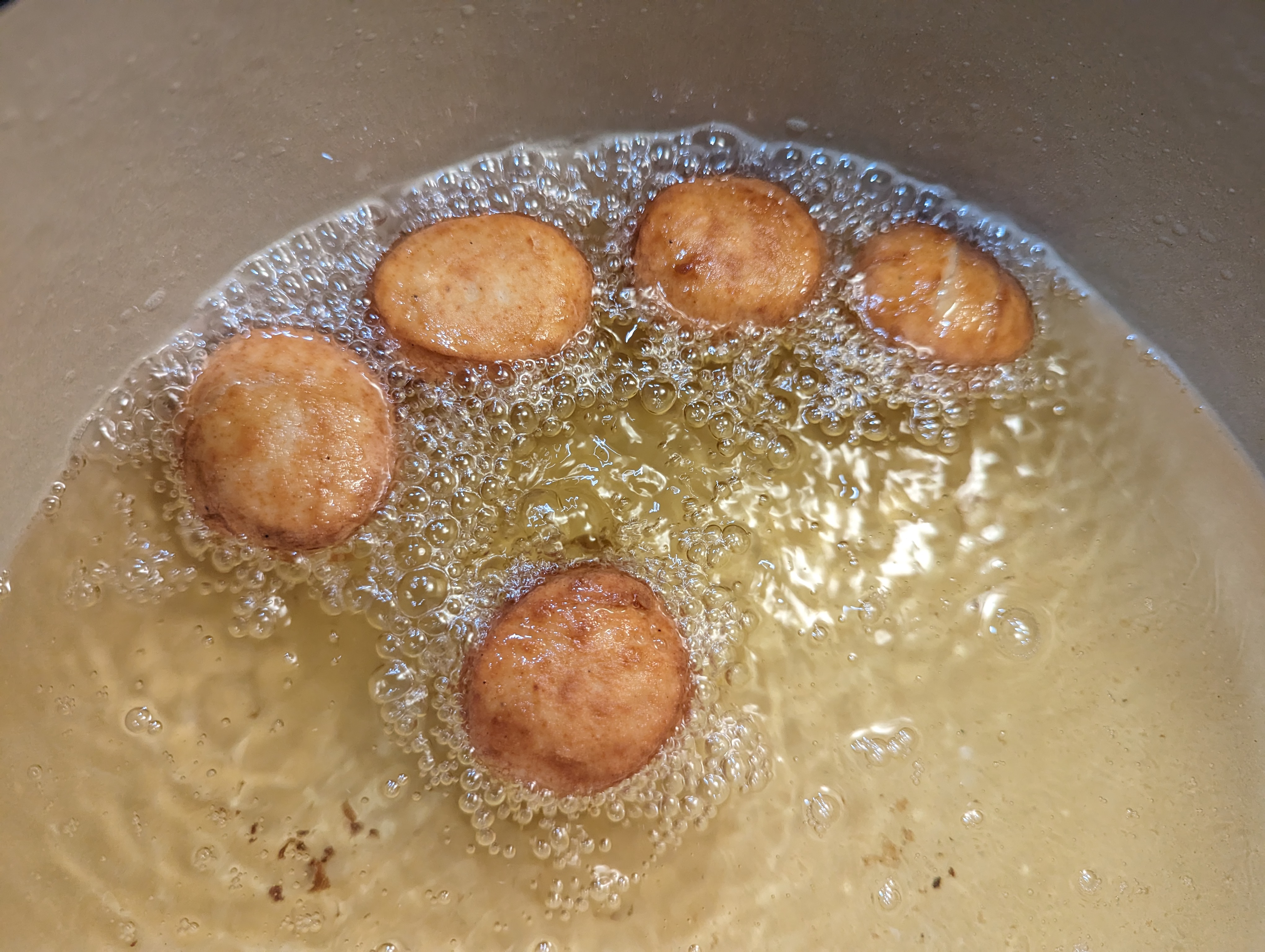
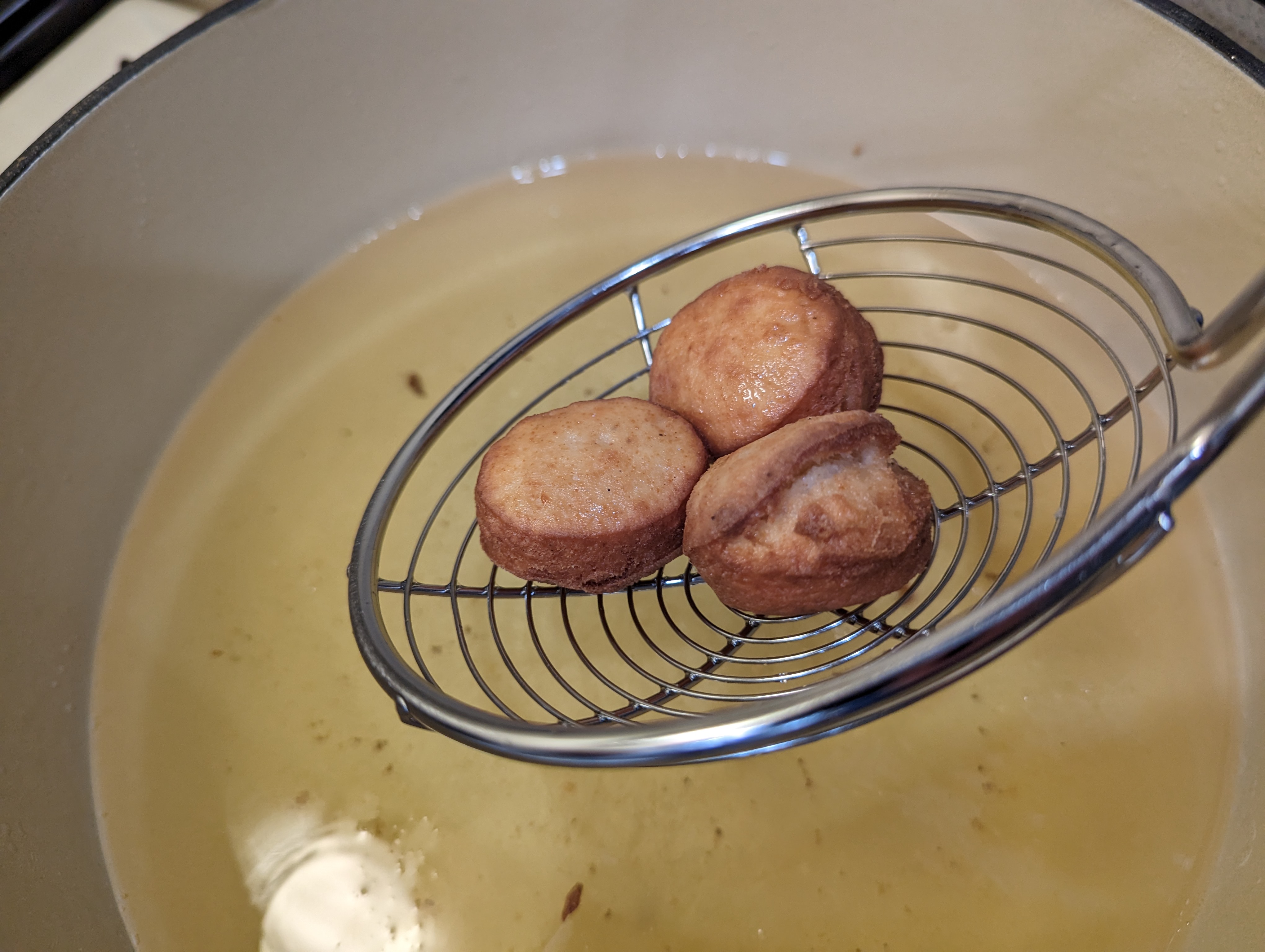
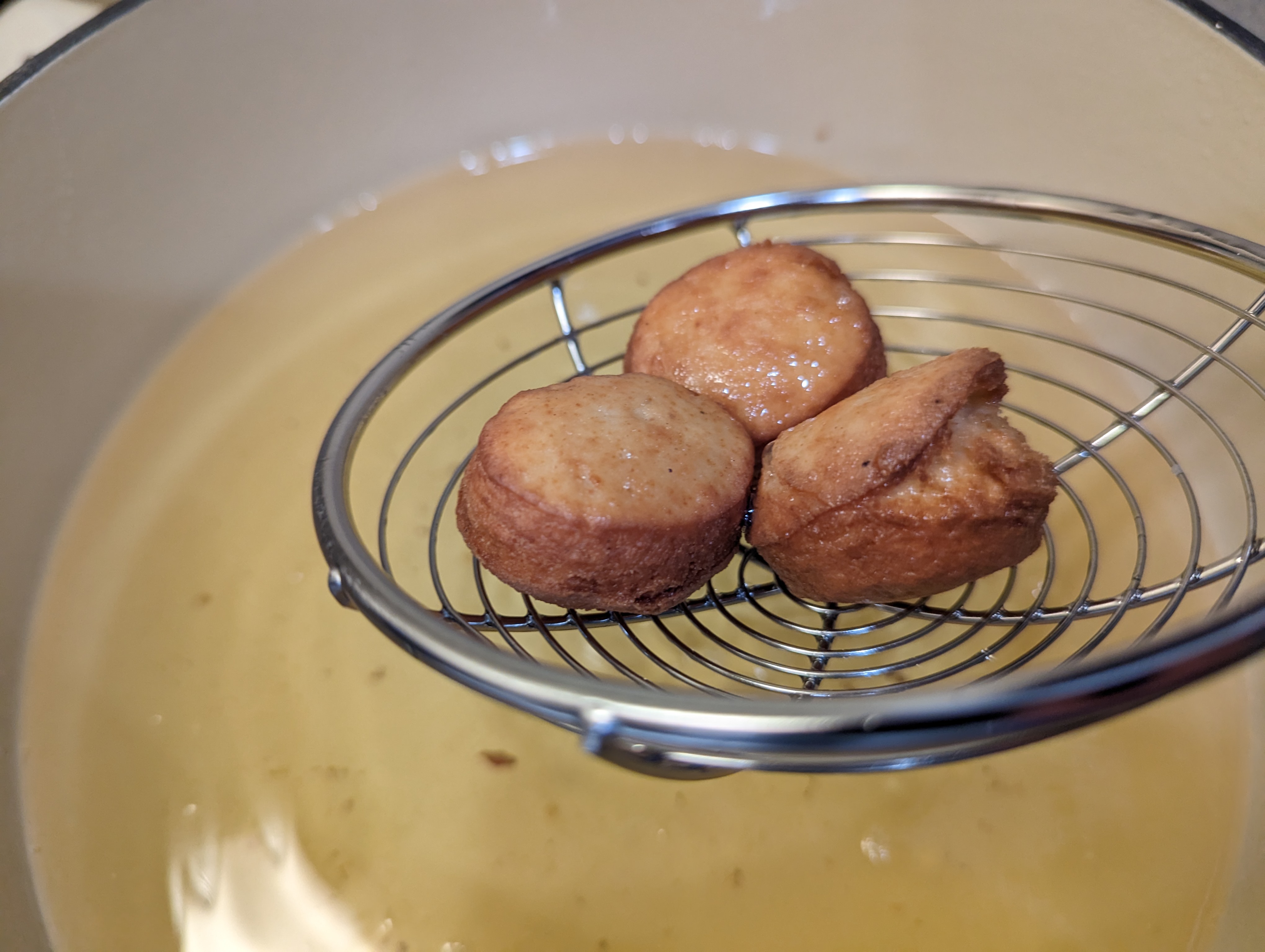
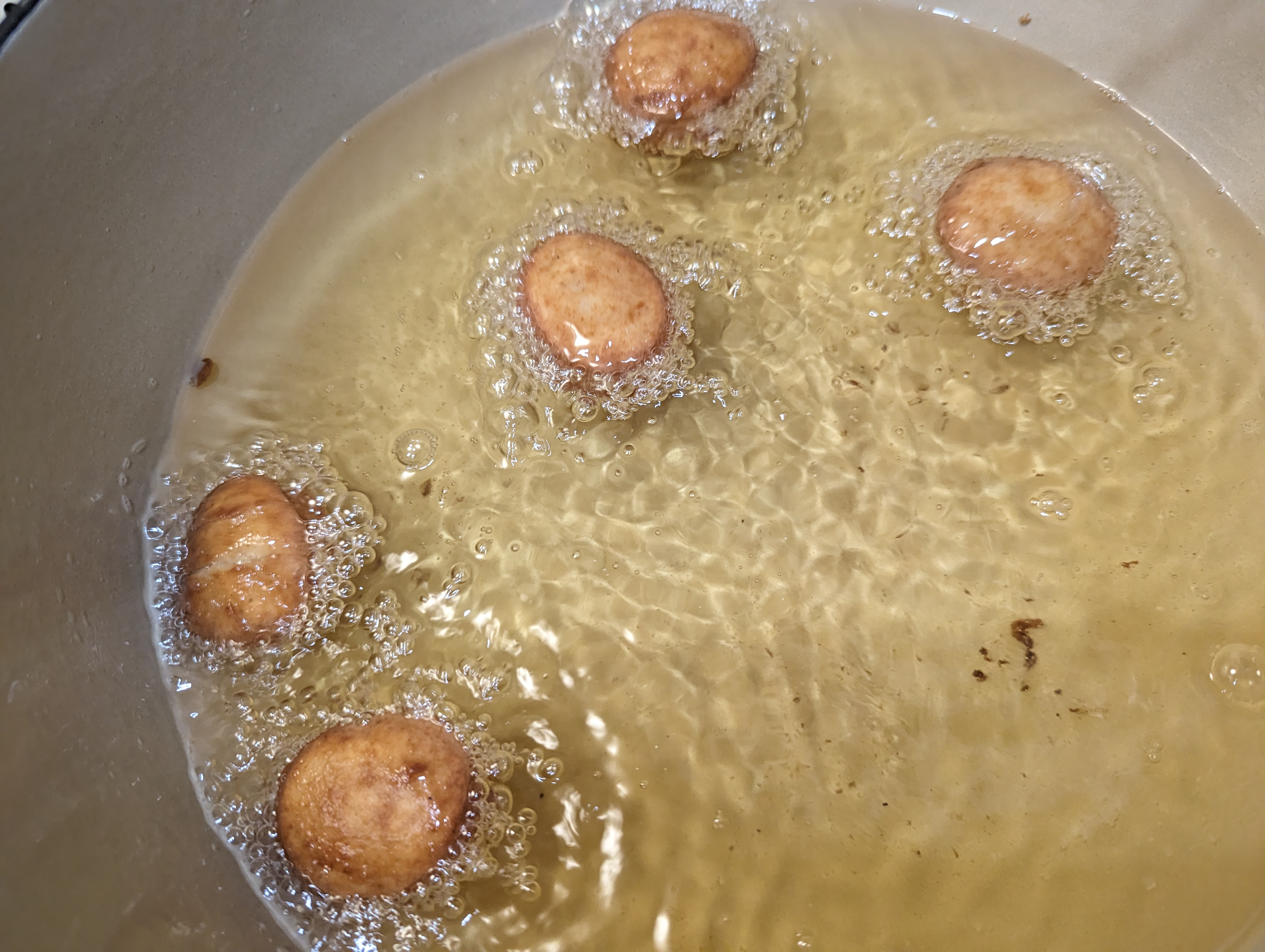
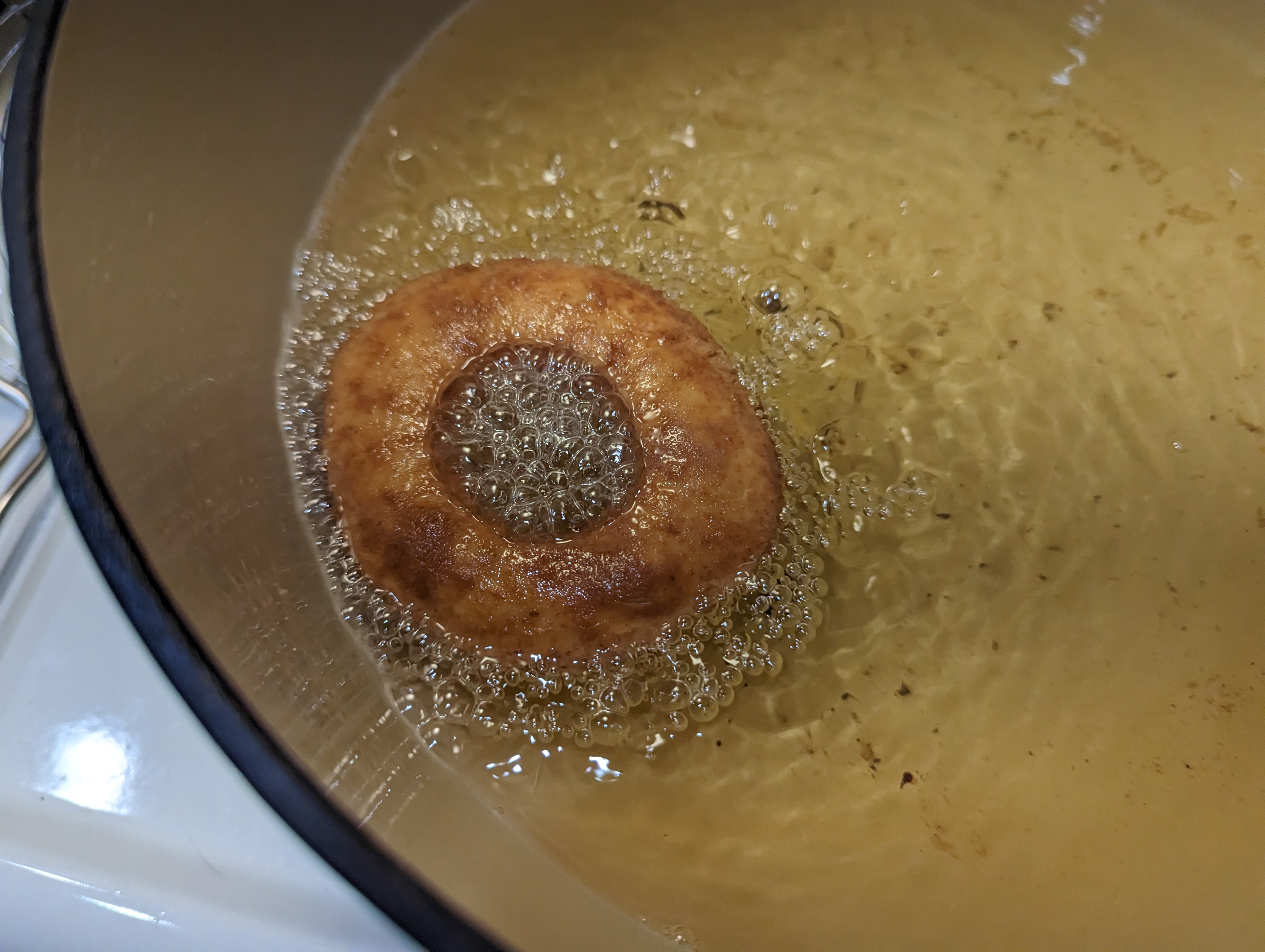
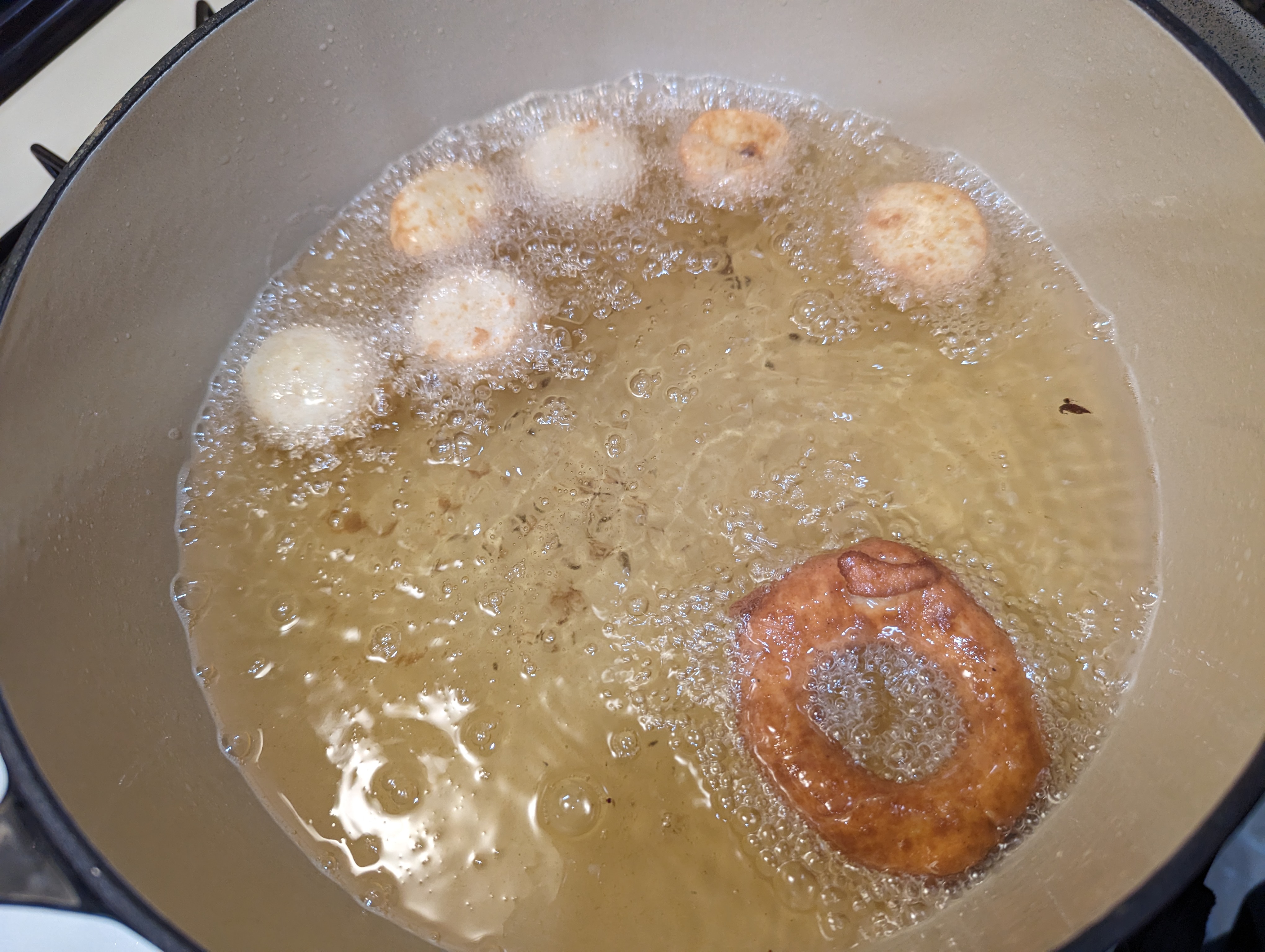
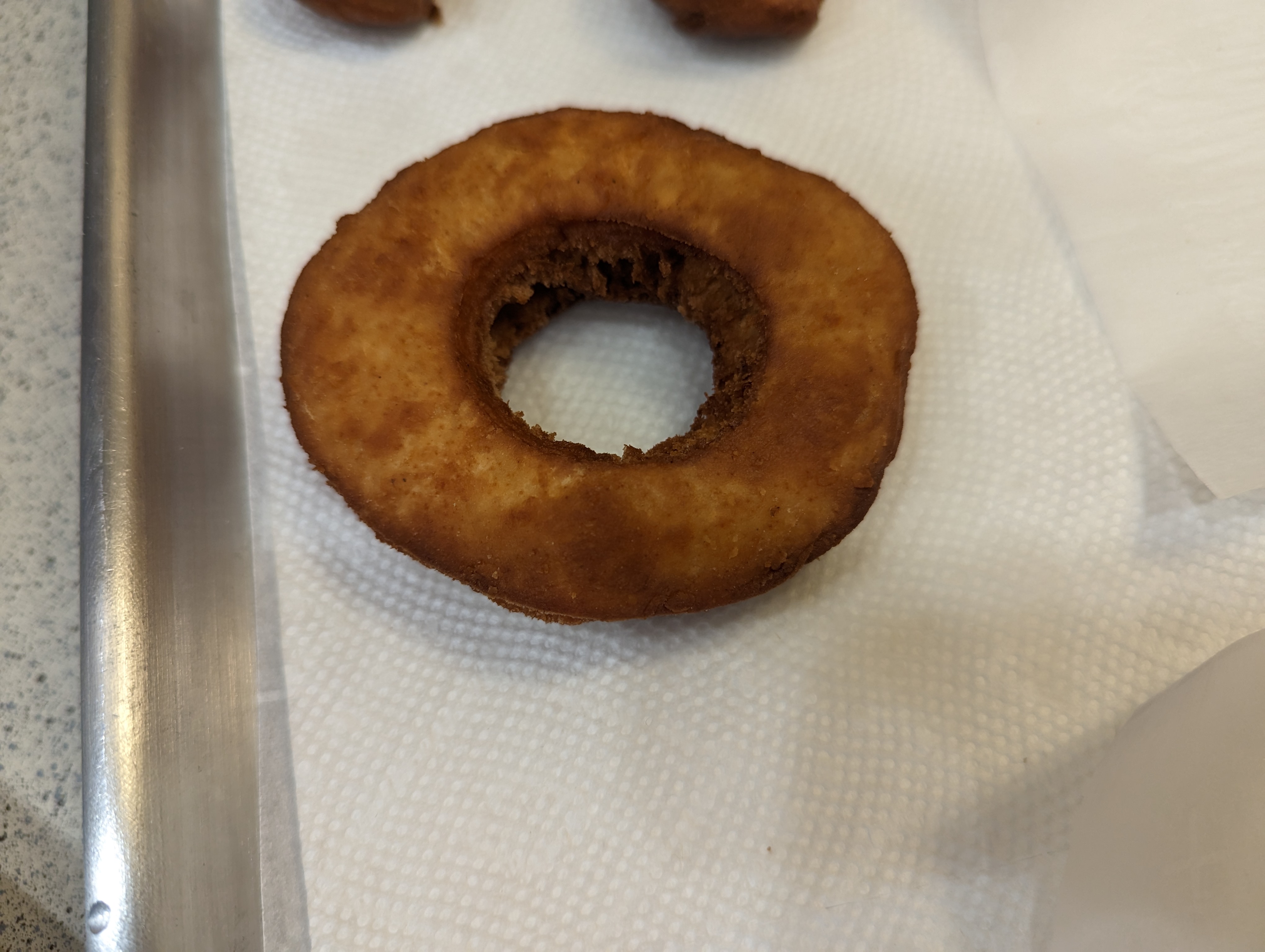
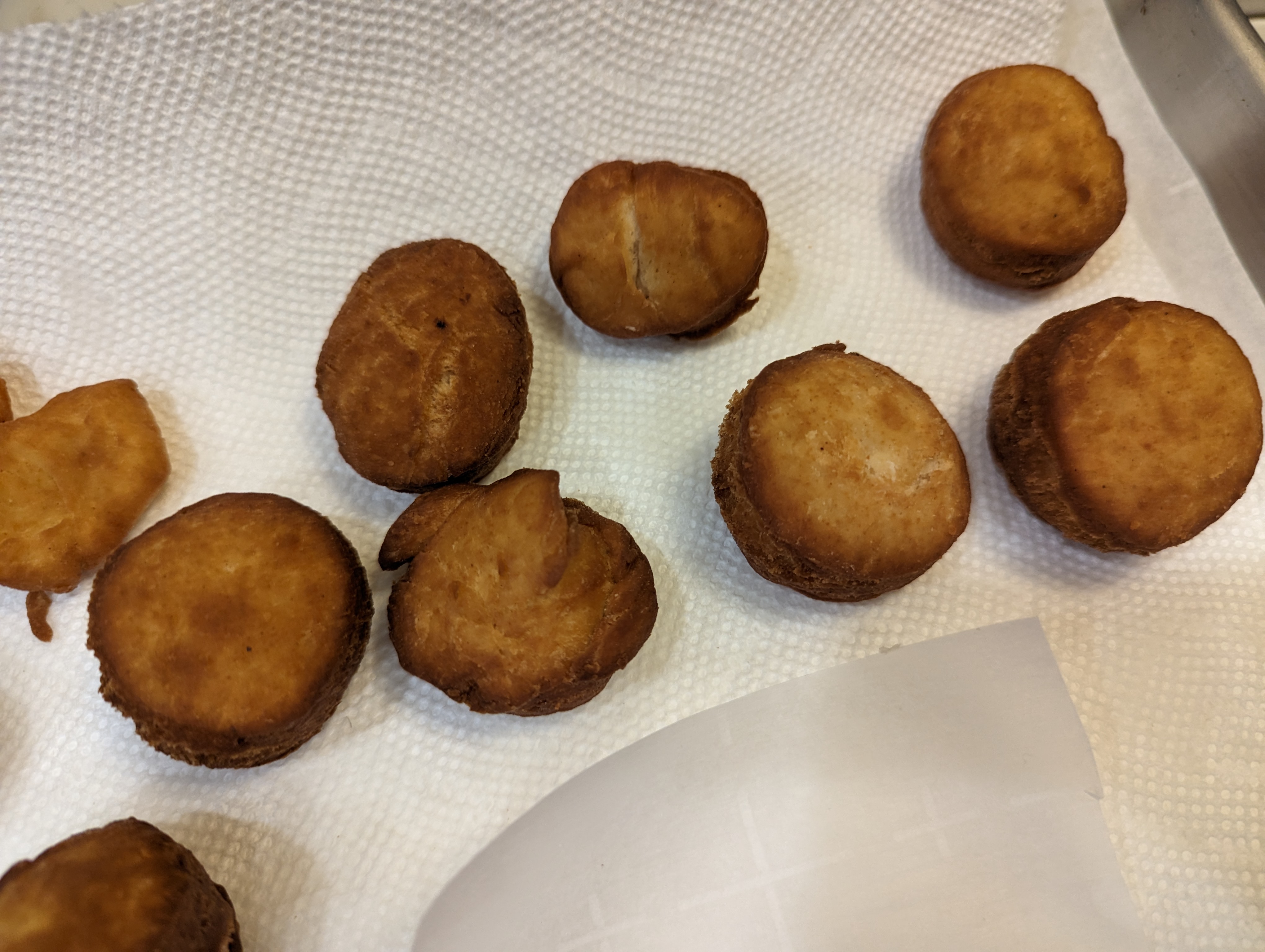
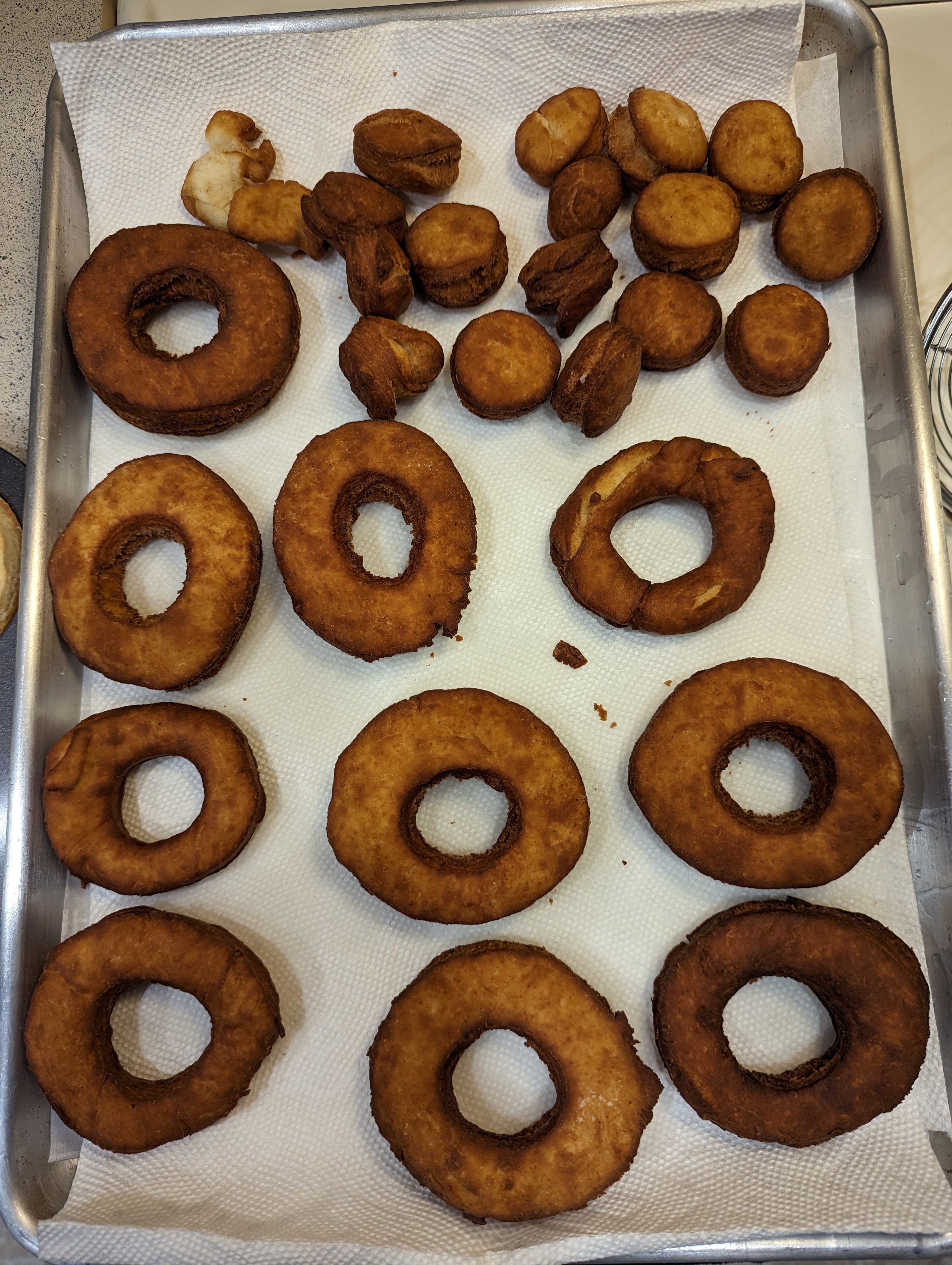
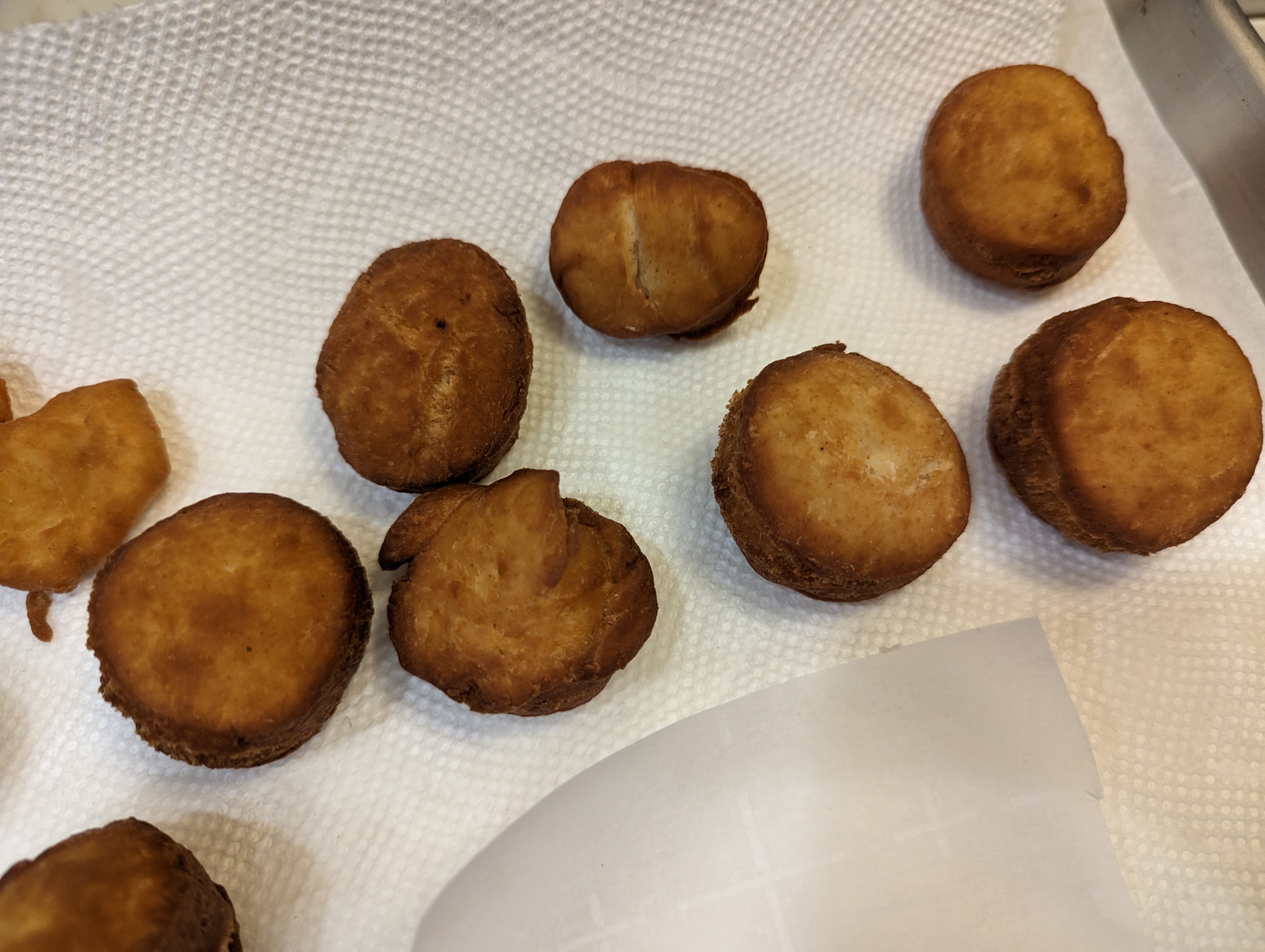
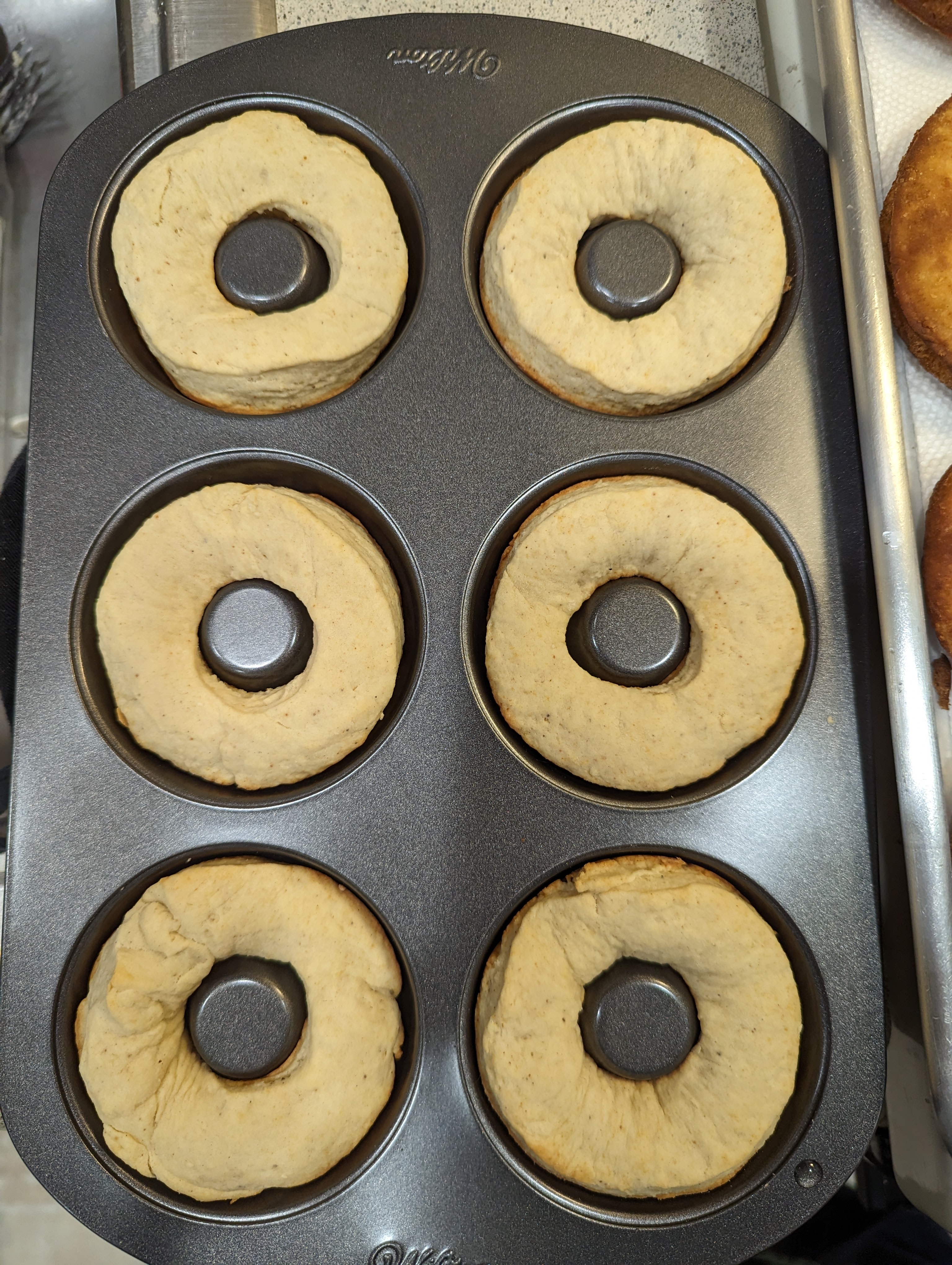
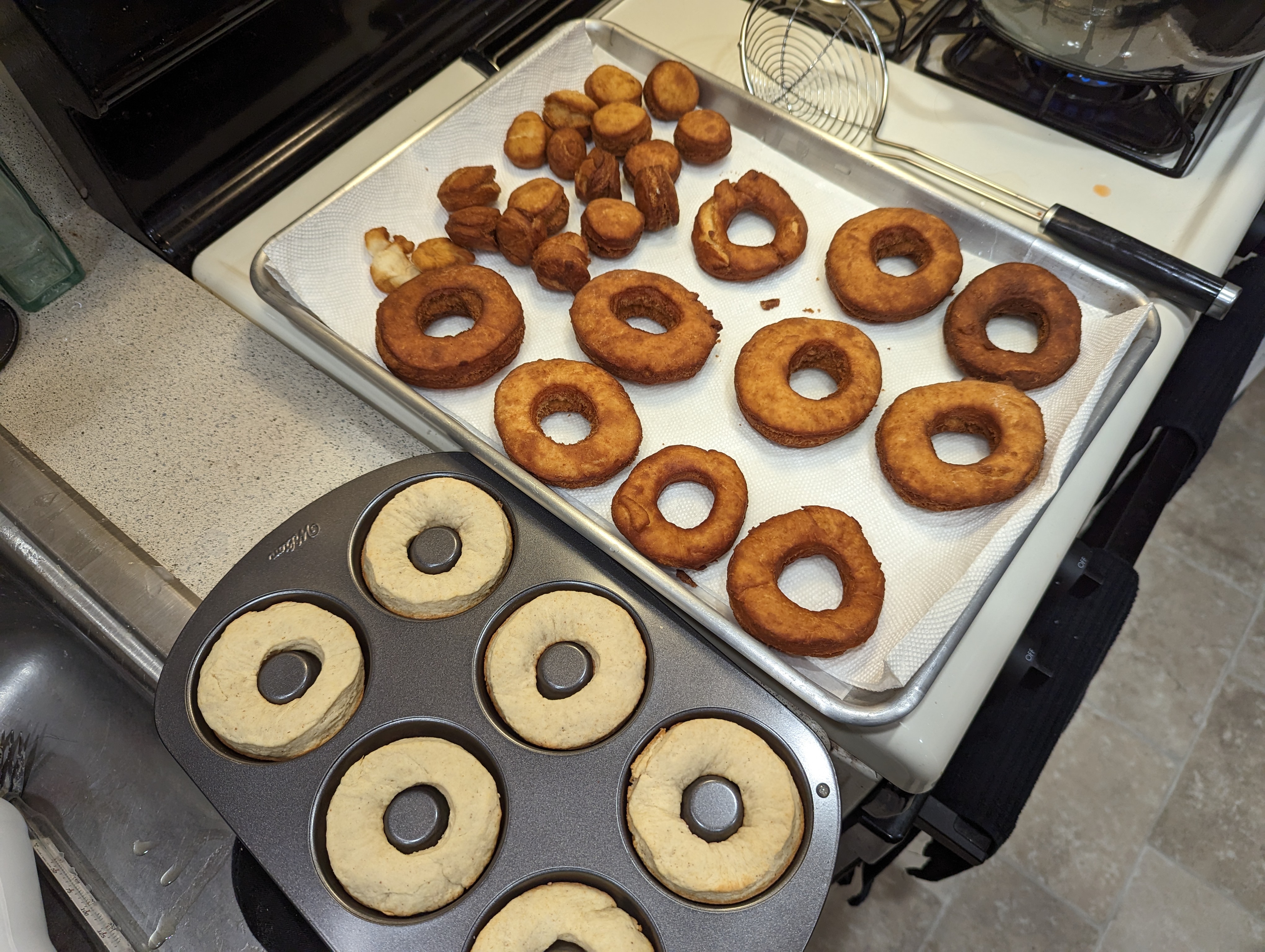
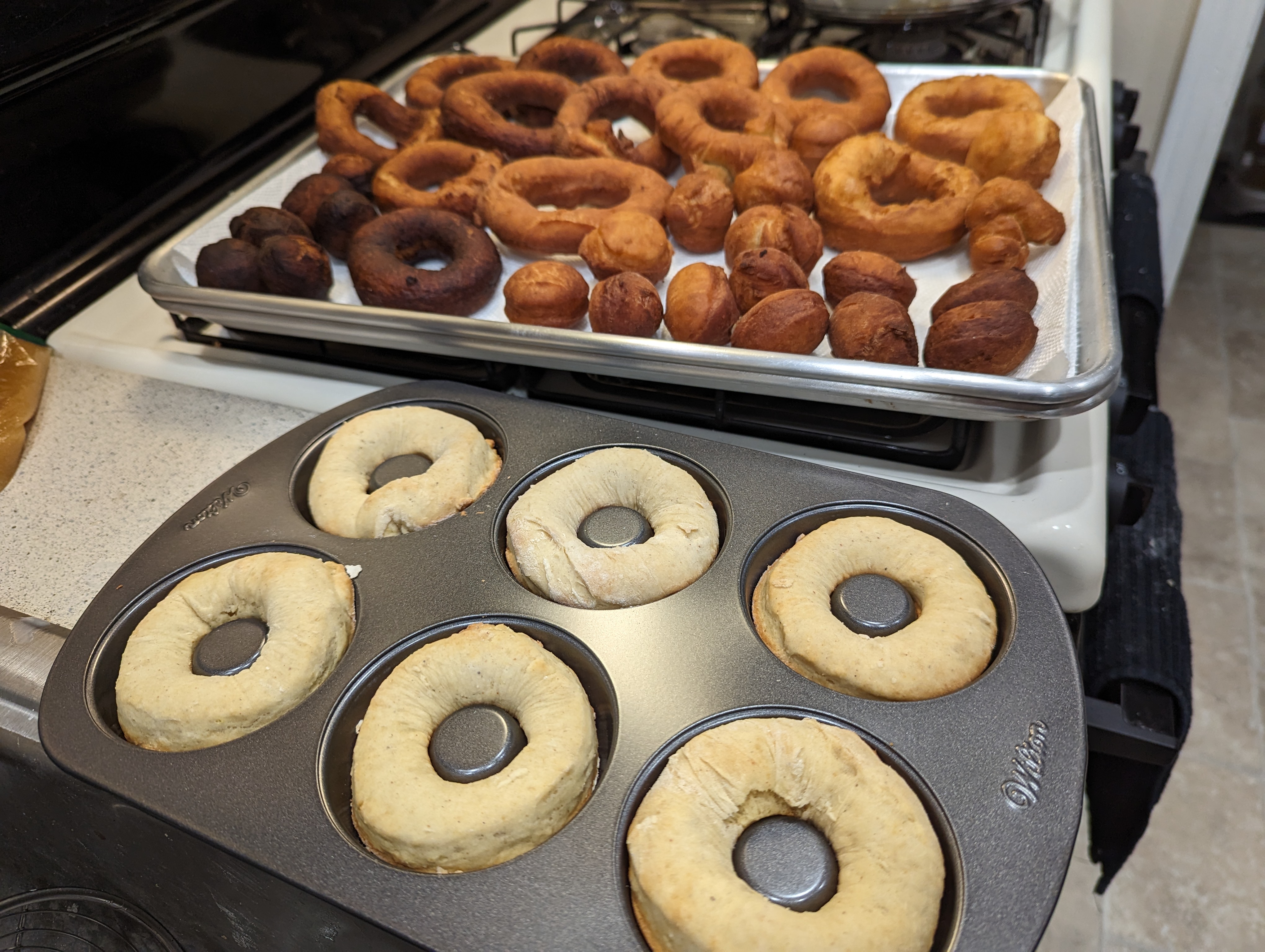
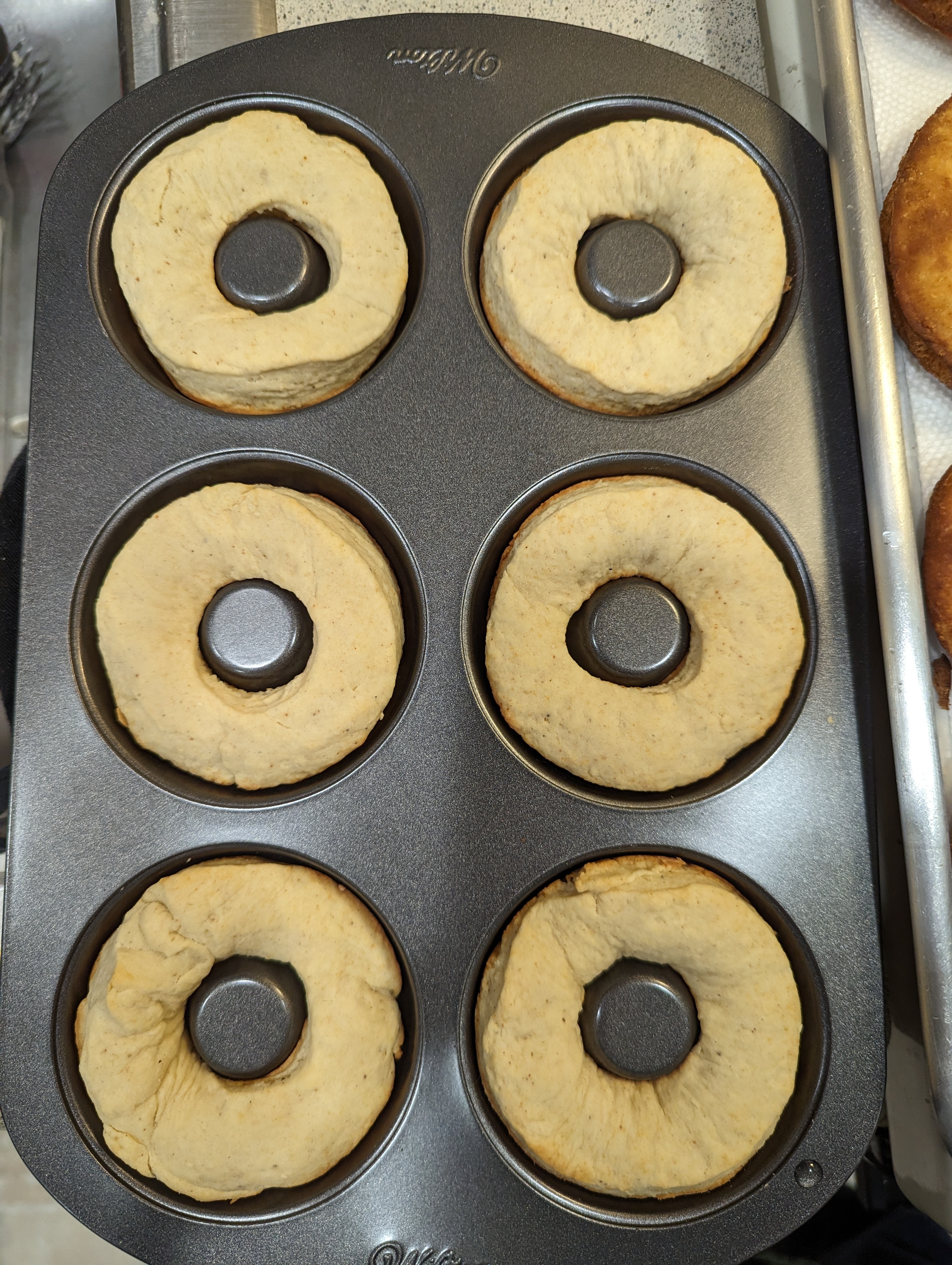
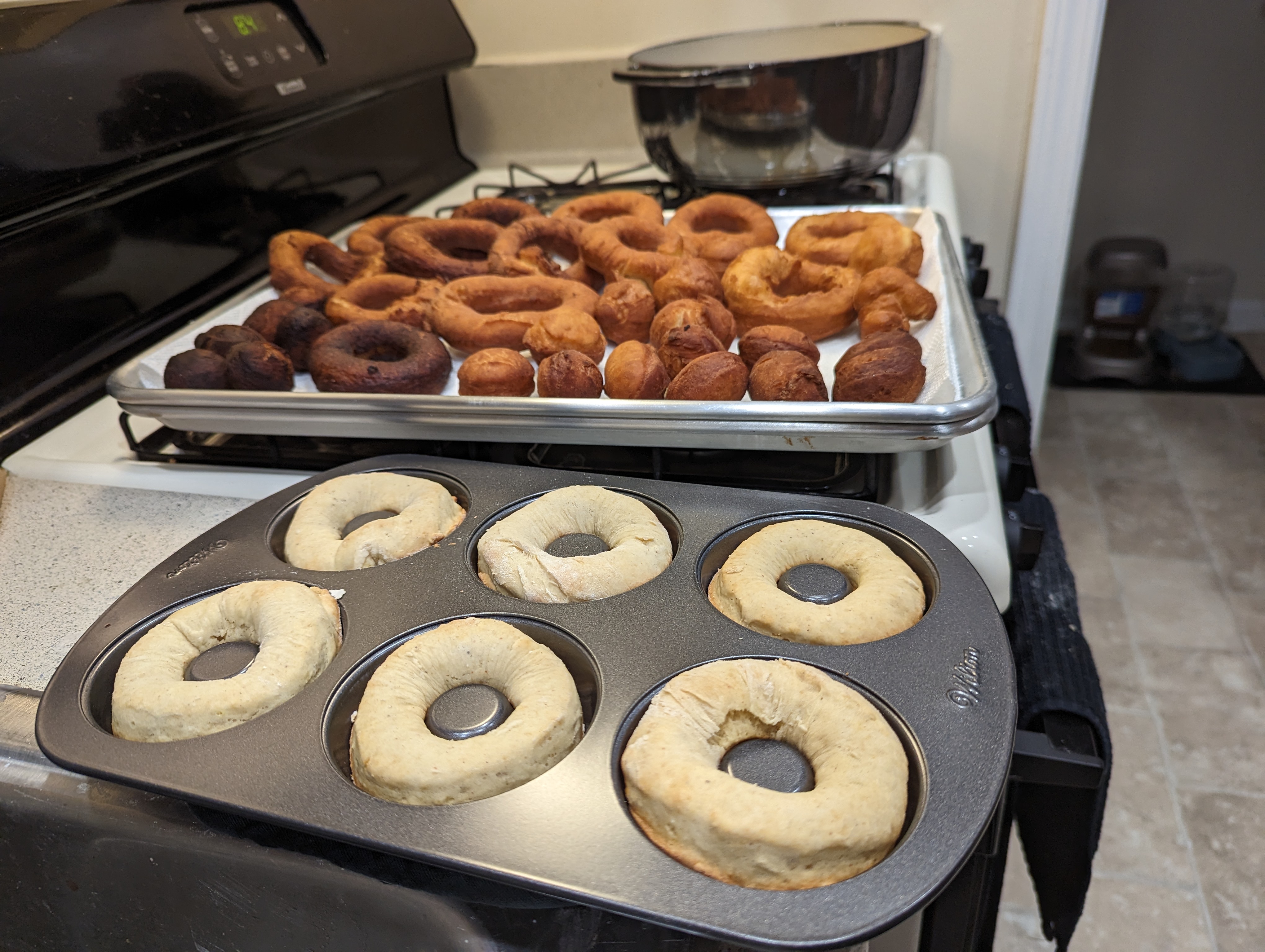
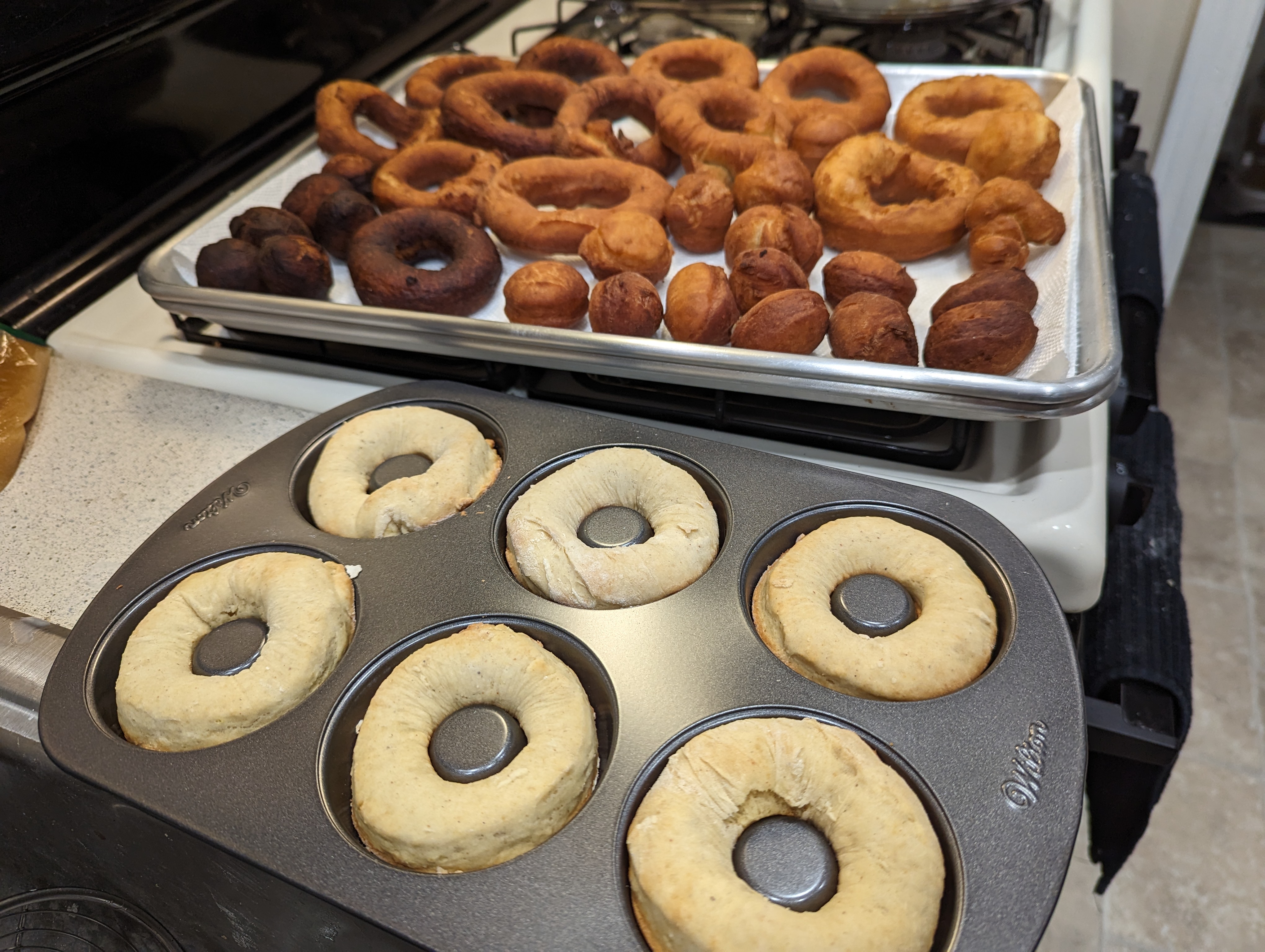
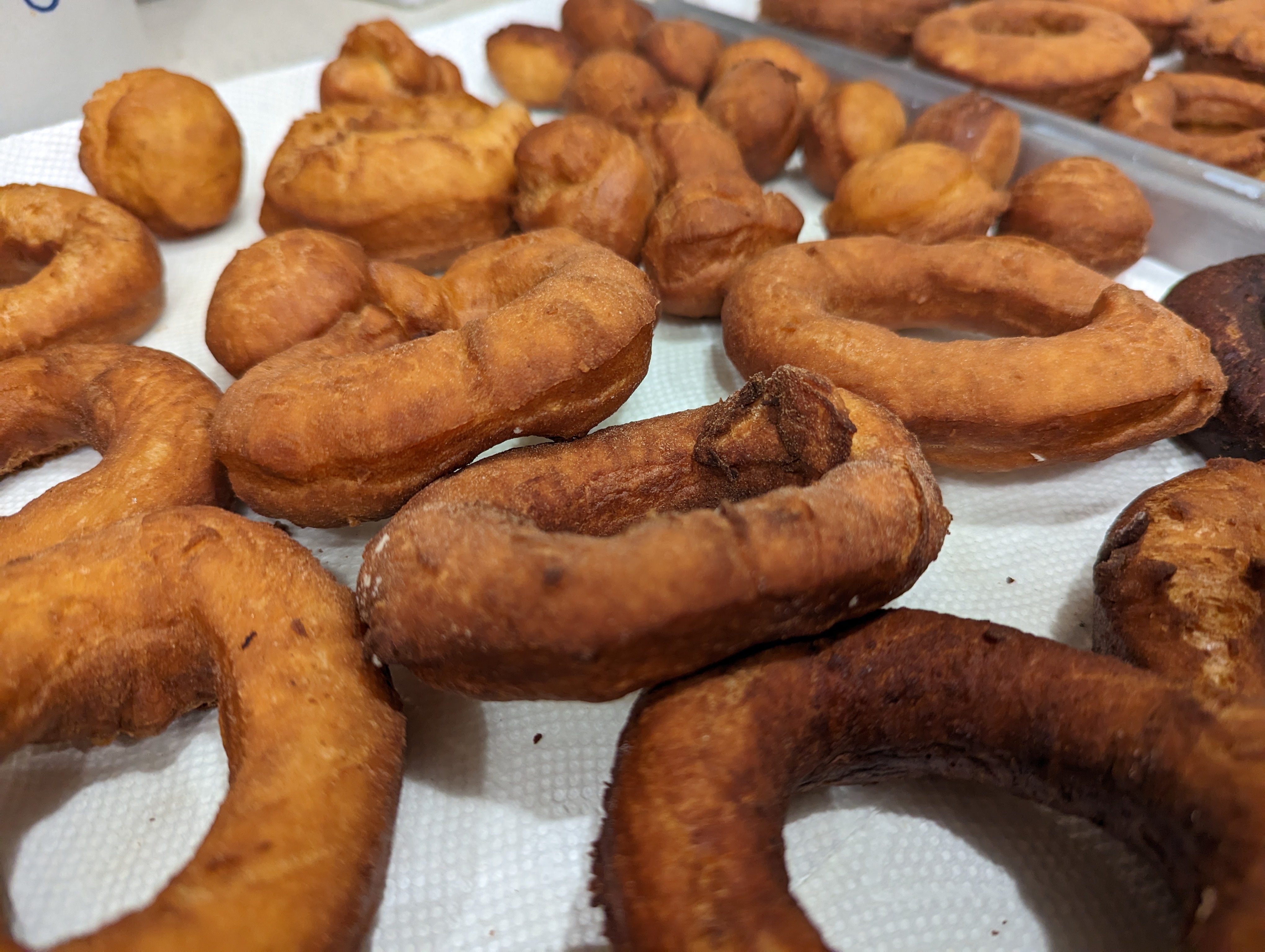
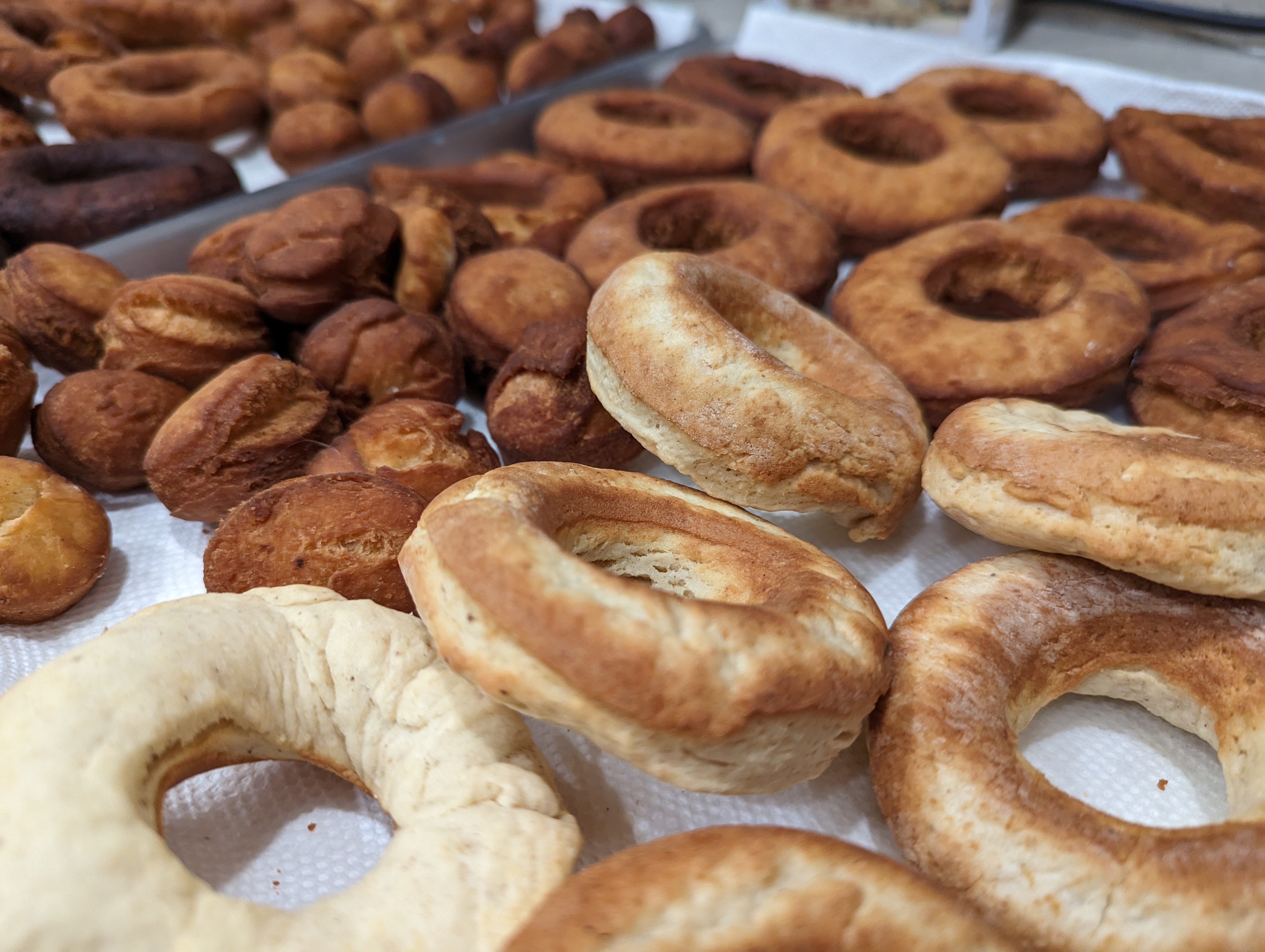
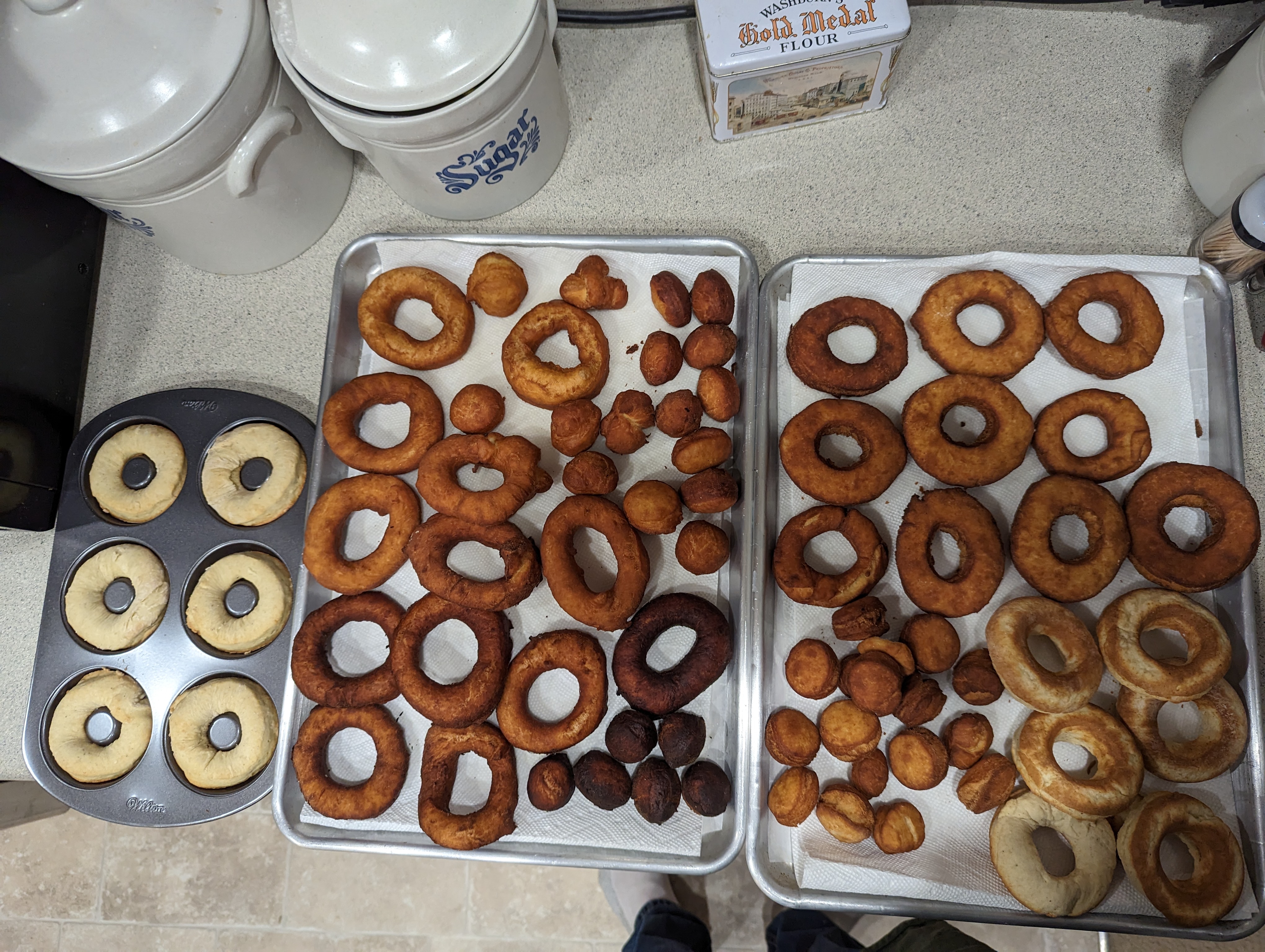
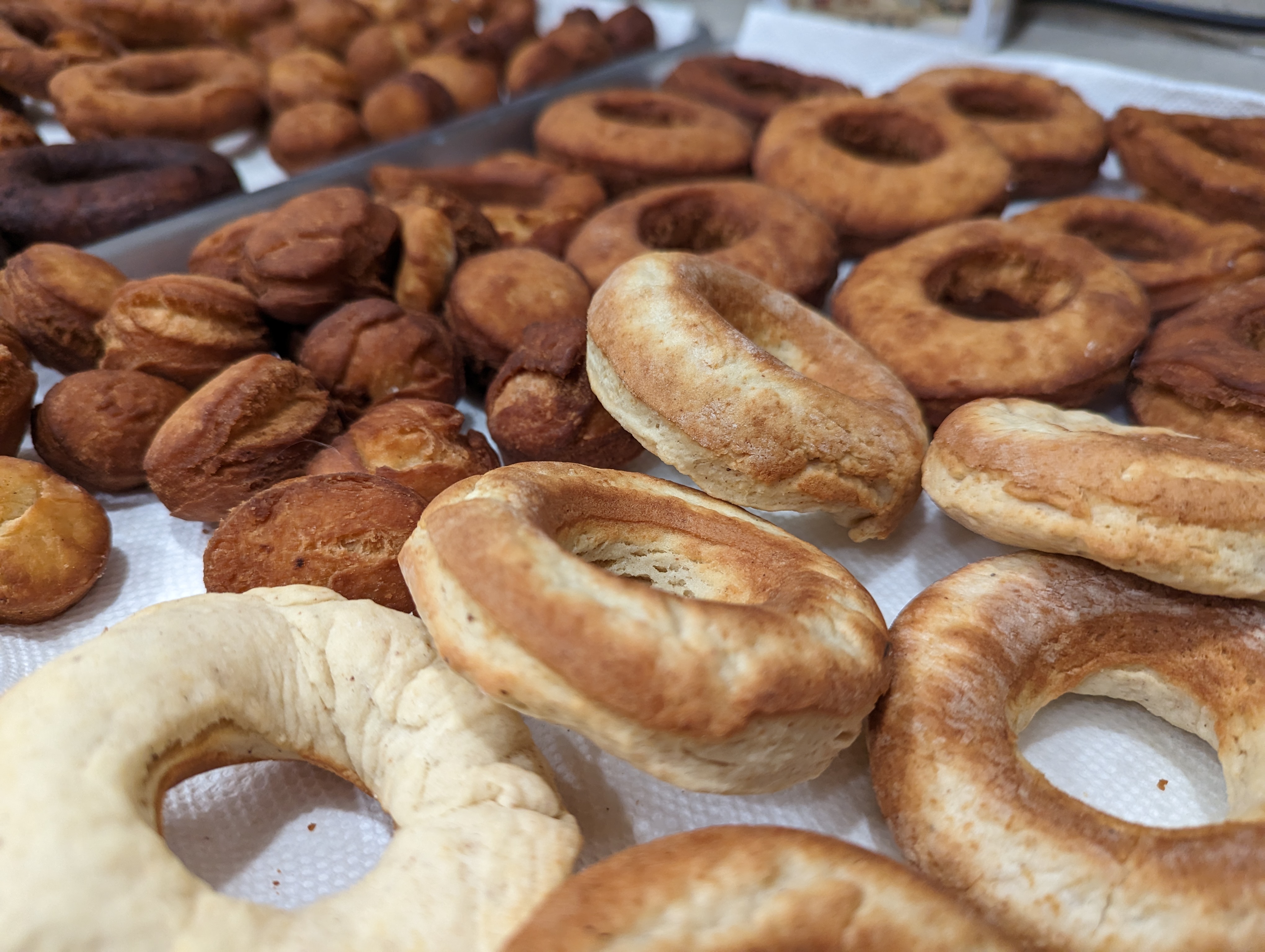
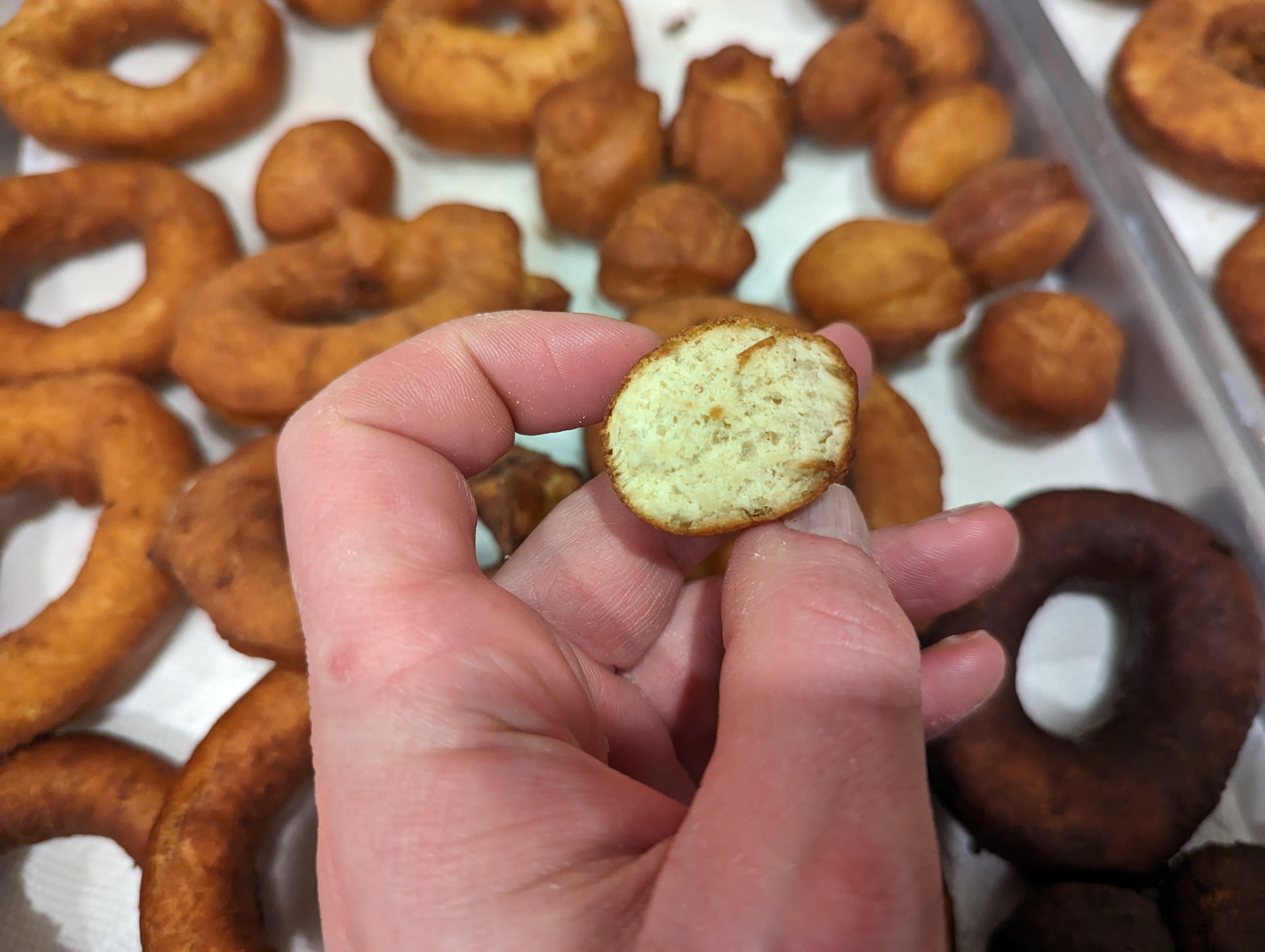
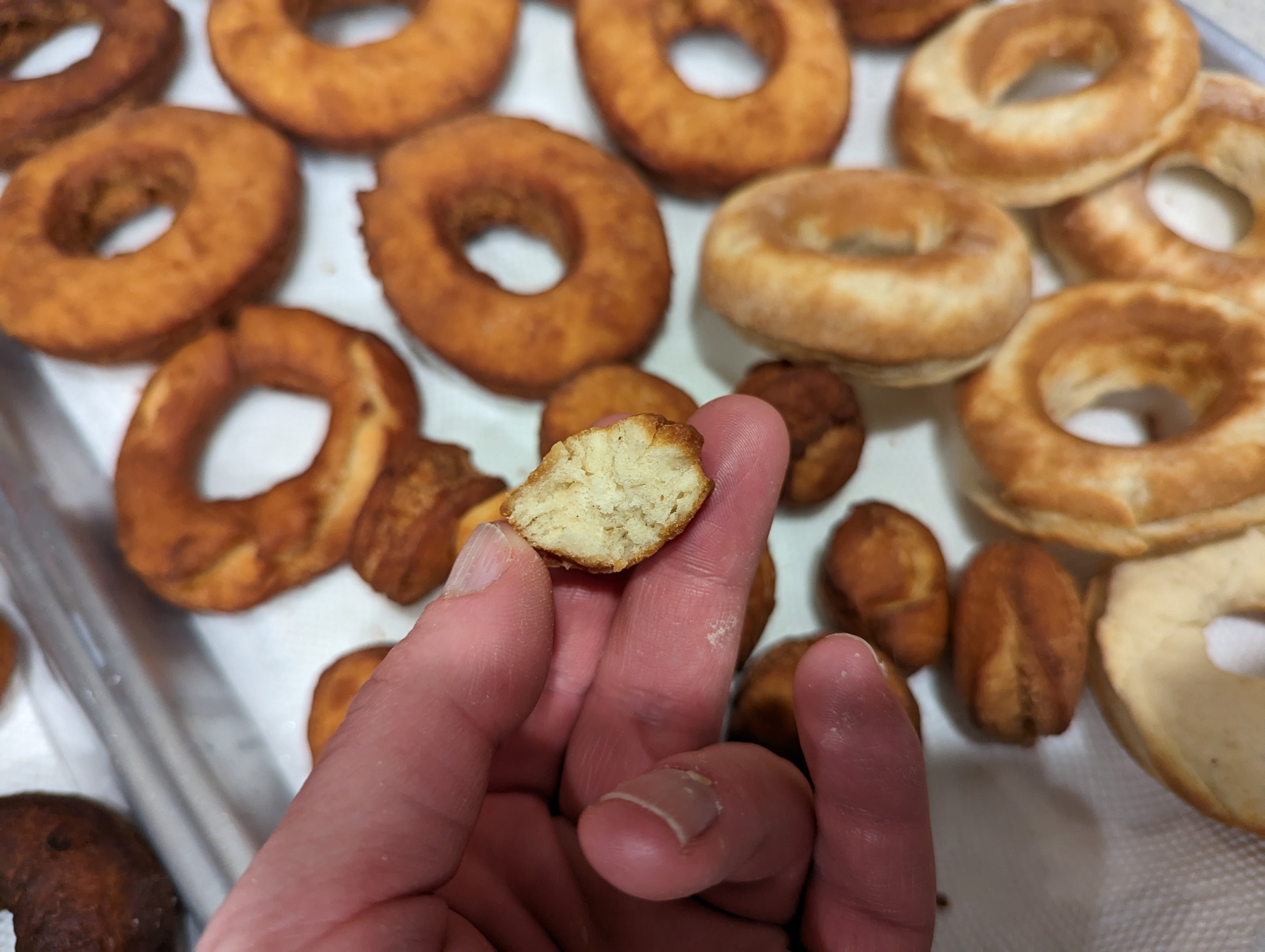
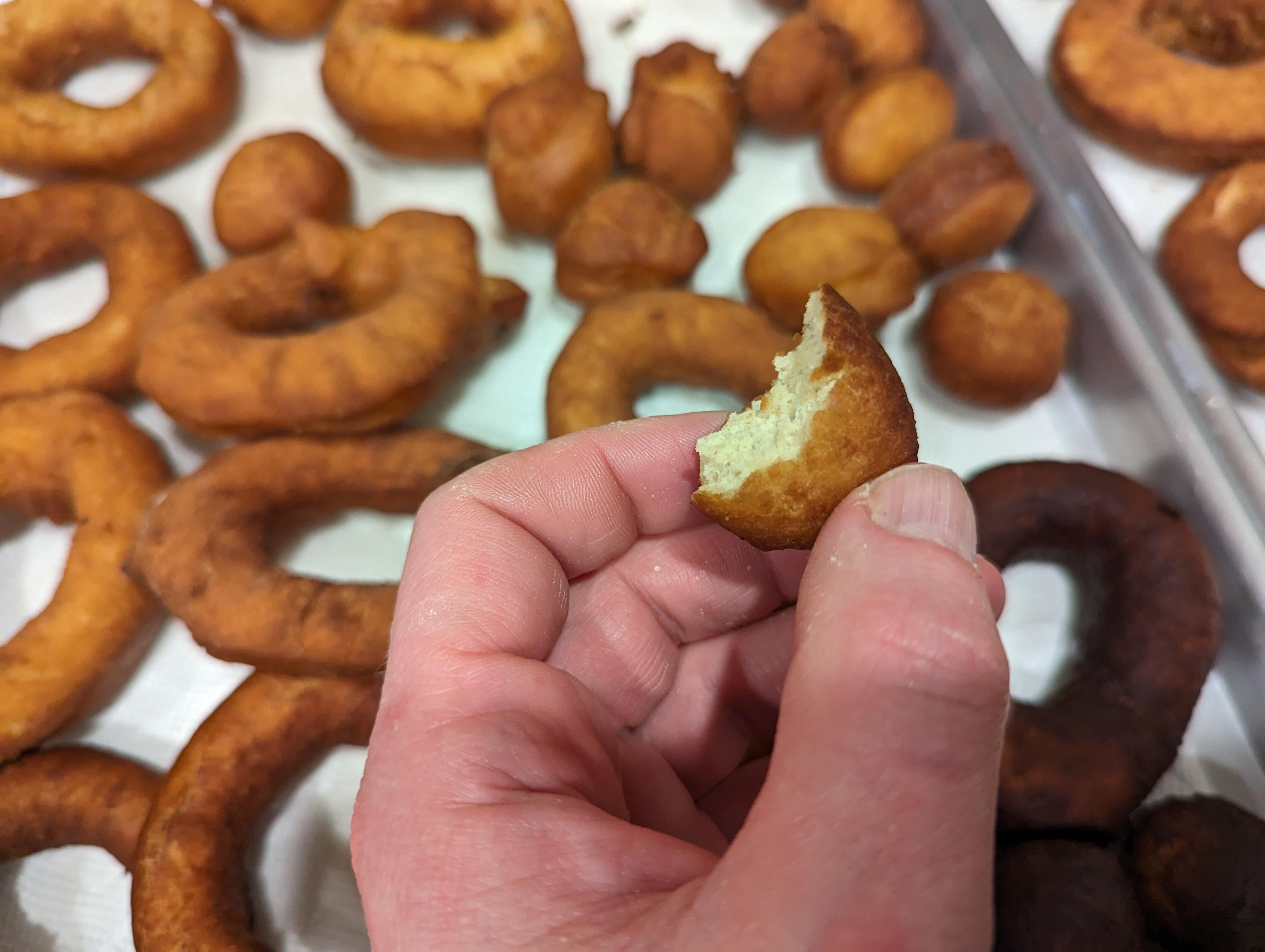
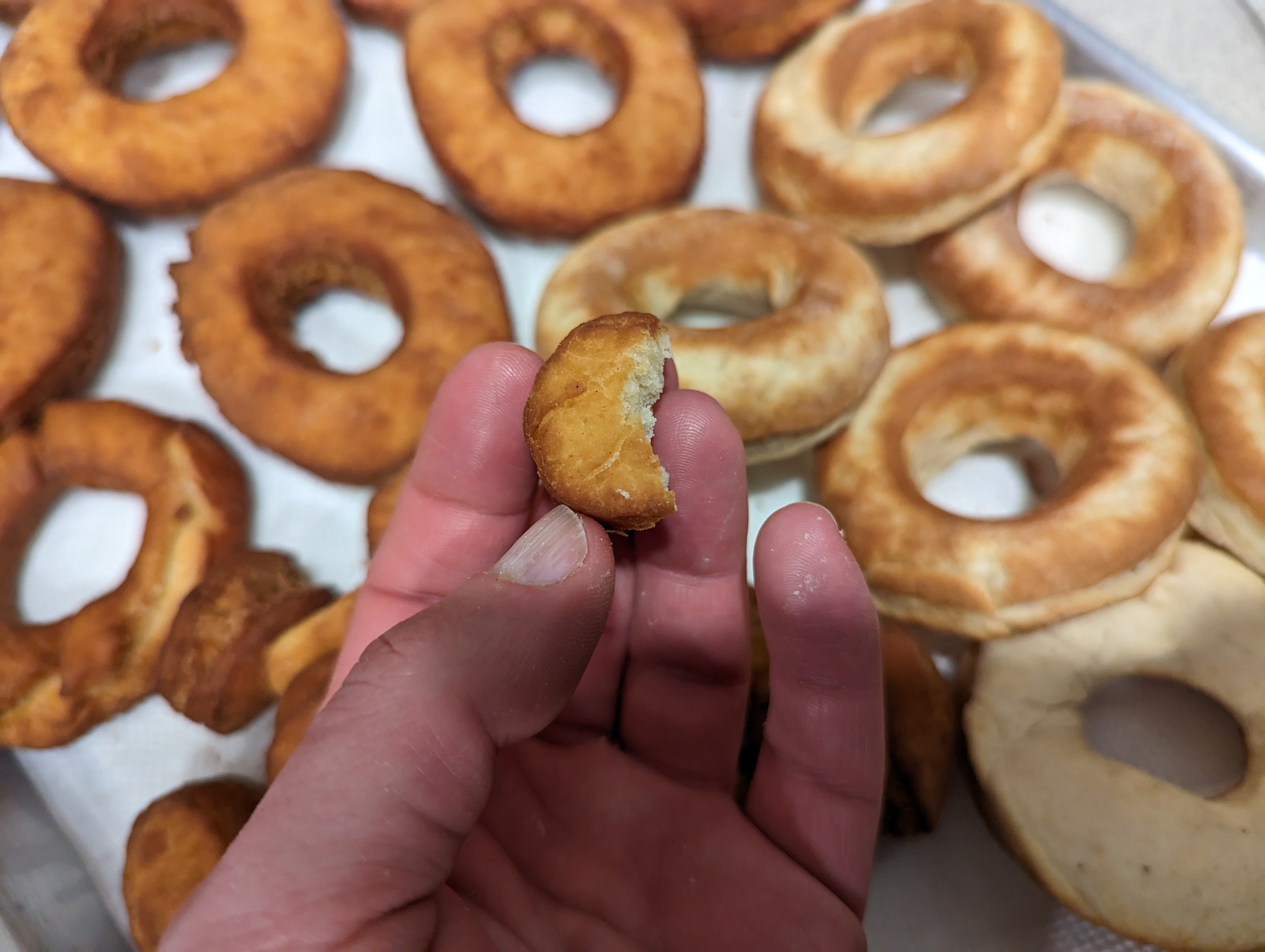
And now for the final verdict, is one recipe really “good,” at least when compared to the other recipe?
There are so many variables that I feel could have influenced my thoughts such as how well I fried the doughnuts (e.g., at what temperature, for how long/too long, etc.), if reusing the shortening imparted any off flavors, if I overworked the dough, etc.
So, I’m not sure if just testing one doughnut hole from one attempt at the recipes is a fair comparison.
However, I do have to say that I did not really notice a super huge difference between the two, both seemed roughly similar to me.
I wish Irene was still around to tell me why she thought one was better than the other and if I did something wrong when making them. Or maybe they were both good but she just had the chance or on whim labeled one while failing to label the other. As sadly so often with her recipes, I’m still left with many questions
Updated Recipes
Irene Caron’s Doughnuts
Yield: 1 ½ to 2 dozen doughnuts
1 egg
½ cup granulated sugar
6 tablespoons lard
1 cup whole milk
4 cups all-purpose flour
2 tablespoons baking powder
1 tsp nutmeg
6 cups (1361g) lard, 6 cups (1106g) vegetable shortening, or 6 cups (1191g) vegetable oil, for frying
If frying: While you prepare the dough, begin heating the lard (best flavor), shortening (less saturated fat but also less flavor), or vegetable oil (probably the healthiest alternative but if you’re doing these for flavor, this is not the choice to make). An 8-quart stock pot is an appropriate size cooking container. Slowly start to heat melt/heat the fat over medium heat; you want it to reach somewhere between 365°F and 375°F before you begin to cook.
If baking: Preheat oven to 350 degrees F.
Beat together the eggs, milk, and sugar until light. In a separate bowl, blend together the flour, baking soda, and nutmeg.
Melt the lard if solid, but make sure it’s not excessively hot. Quickly blend the dry ingredients with the wet and stir in the melted lard. The resulting dough will be quite soft, but if you keep your work surfaces well sprinkled with flour, you can deal with it.
Turn the dough out onto a floured surface, and knead four or five times to make it cohesive (a baker’s bench knife helps here). Then, with a well-floured rolling pin, roll the dough out until it’s about ¼ to 1/2-inch thick.
With a doughnut cutter dipped in flour (each time you cut), cut out doughnuts. Save the “holes” or re-roll them with leftover dough. Try to handle the dough as little as possible.
If frying: When the fat is at the appropriate temperature (365°F to 375°F), lower three or four doughnuts into it. A slotted spoon is useful here. The doughnuts will initially sink to the bottom of the pot but will rise shortly. Give them a minute or so on one side, then flip them over and give them another minute. Flip them a third time and cook for another 30 seconds. Drain on paper towels (or brown paper grocery bags).
If baking: Place doughnuts in an ungreased doughnut pan and bake in over for 10-12 minutes. Once finished baking, allow to cool in pan before removing.
Store cooled doughnuts, well wrapped, at room temperature for a couple of days. Freeze for longer storage.
Notes: These doughnuts could use a glaze or coating as they are relatively bland with only nutmeg as a flavoring. For cinnamon doughnuts, shake warm doughnuts in a plastic bag with about 1/4 (50g) to 1/3 cup (68g) cinnamon sugar. For sugar-coated doughnuts, shake doughnuts in a plastic bag with about 1/2 cup (57g) non-melting topping sugar (for best results), or confectioners’ sugar. For frosted doughnuts, see King Author Flour’s three easy doughnut glazes. Sprinkle the glazed doughnuts with toasted coconut or chopped nuts, if desired.
Irene Caron’s Good Doughnuts
Yield: 1 ½ to 2 dozen doughnuts
1 tsp lemon juice
1 cup milk
4 ½ cups all-purpose flour
½ cups granulated sugar
1 teaspoon baking soda
1 tsp nutmeg
Pinch of salt
3 eggs
5 tablespoons lard, melted
6 cups (1361g) lard, 6 cups (1106g) vegetable shortening, or 6 cups (1191g) vegetable oil, for frying
If frying: While you prepare the dough, begin heating the lard (best flavor), shortening (less saturated fat but also less flavor), or vegetable oil (probably the healthiest alternative but if you’re doing these for flavor, this is not the choice to make). An 8-quart stock pot is an appropriate size cooking container. Slowly start to heat melt/heat the fat over medium heat; you want it to reach somewhere between 365°F and 375°F before you begin to cook.
If baking: Preheat oven to 350 degrees F.
Combine lemon juice and milk in a small bowl, set aside for at least five minutes. Beat together the eggs and sugar until light. In a separate bowl, blend together the flour, salt, baking soda, and nutmeg.
Melt the lard, but make sure it’s not excessively hot. Quickly blend the dry ingredients with the wet and stir in the melted lard and milk. The resulting dough will be quite soft, but if you keep your work surfaces well sprinkled with flour, you can deal with it.
Turn the dough out onto a floured surface, and knead four or five times to make it cohesive (a baker’s bench knife helps here). Then, with a well-floured rolling pin, roll the dough out until it’s about 1/2-inch thick.
With a doughnut cutter dipped in flour (each time you cut), cut out doughnuts. Save the “holes” or re-roll them with leftover dough. Try to handle the dough as little as possible.
If frying: When the fat is at the appropriate temperature (365°F to 375°F), lower three or four doughnuts into it. A slotted spoon is useful here. The doughnuts will initially sink to the bottom of the pot but will rise shortly. Give them a minute or so on one side, then flip them over and give them another minute. Flip them a third time and cook for another 30 seconds. Drain on paper towels (or brown paper grocery bags).
If baking: Place doughnuts in an ungreased doughnut pan and bake in over for 10-12 minutes. Once finished baking, allow to cool in pan before removing.
Store cooled doughnuts, well wrapped, at room temperature for a couple of days. Freeze for longer storage.Notes: These doughnuts could use a glaze or coating as they are relatively bland with only nutmeg as a flavoring. For cinnamon doughnuts, shake warm doughnuts in a plastic bag with about 1/4 (50g) to 1/3 cup (68g) cinnamon sugar. For sugar-coated doughnuts, shake doughnuts in a plastic bag with about 1/2 cup (57g) non-melting topping sugar (for best results), or confectioners’ sugar. For frosted doughnuts, see King Author Flour’s three easy doughnut glazes. Sprinkle the glazed doughnuts with toasted coconut or chopped nuts, if desired.
References
- Brinna Sands’ Old-Fashioned Cake Doughnuts recipe on King Author Flour’s website, accessed 20 Dec 2022, https://www.kingarthurbaking.com/recipes/old-fashioned-cake-doughnuts-recipe
- PJ Hamel’s Baked Doughnuts Three Ways recipe on King Author Flour’s website, accessed 20 Dec 2022, https://www.kingarthurbaking.com/recipes/baked-doughnuts-three-ways-recipe
- PJ Hamel’s Three Easy Doughnut Glazes recipe on King Author Flour’s website, accessed 31 Dec 2022, https://www.kingarthurbaking.com/recipes/three-easy-doughnut-glazes-recipe
Next Steps: Pickles!
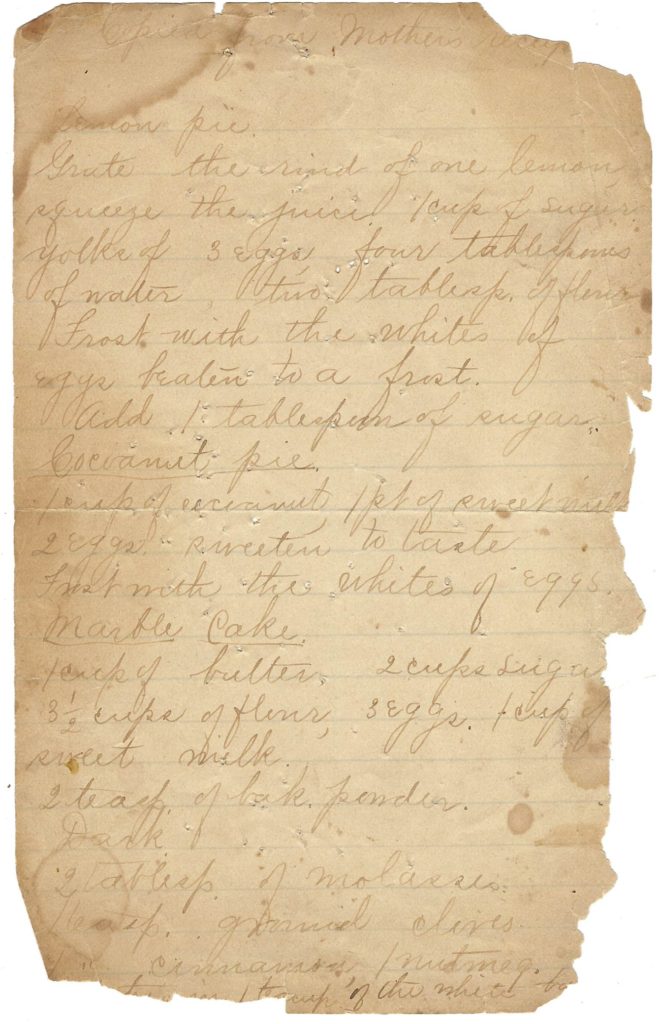
The next steps in this project are to make my great-grandmother’s recipe for Delicious Pickles which included a surprise canning adventure! Turns out that some things are hard to do in a home kitchen…
You can read about regarding my experiences making that recipe and the struggles I overcame while doing it in Irene’s Recipes #10: Pickles – A Lesson in Humility in the Kitchen!
